Highlights of the Amsterdam Pipe Museum
Auteur:
Don Duco
Original Title:
Hoogtepunten uit het Amsterdam Pipe Museum
Année de publication:
2020
Éditeur:
Amsterdam Pipe Museum (Stichting Pijpenkabinet)
Wooden pipe bowl with mirror monogram
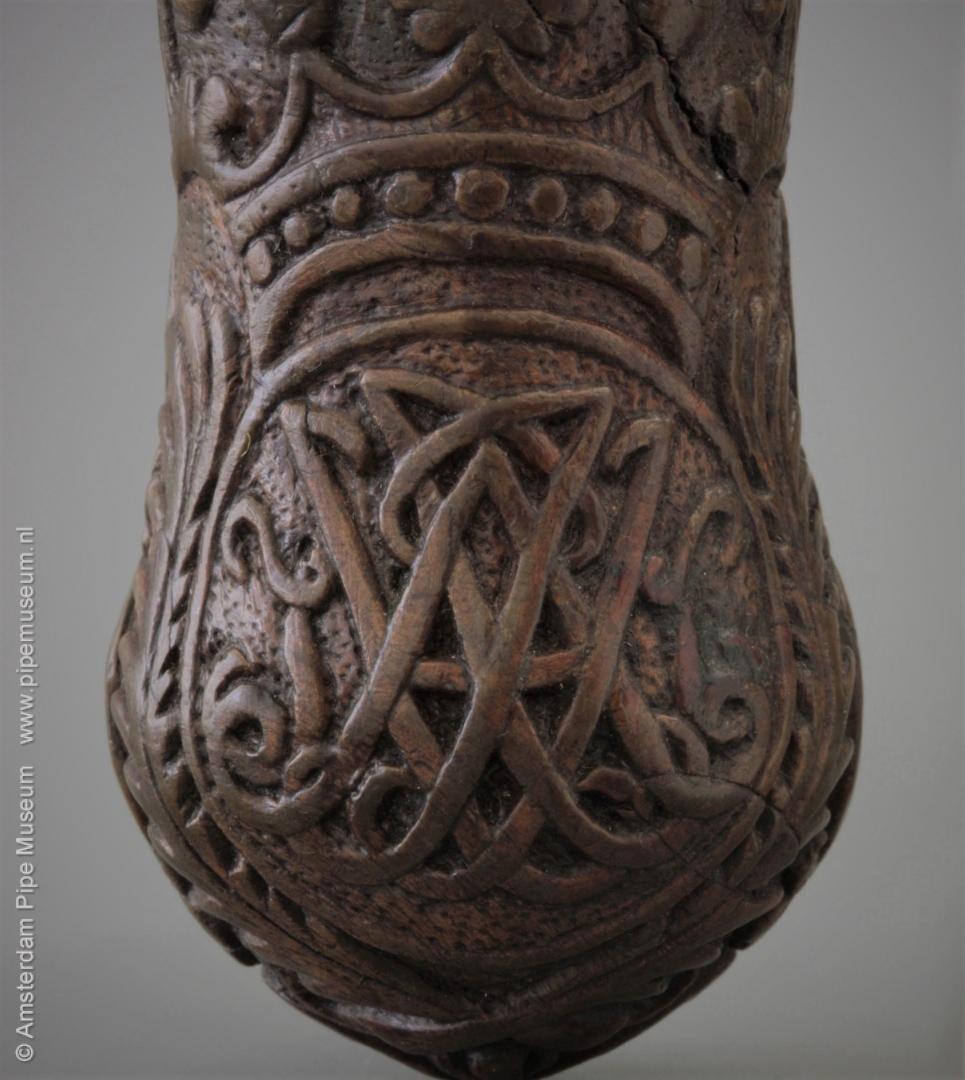
The bowl shape of this early wooden pipe is called kalmas, a shape that originated in Turkey. Already in the seventeenth century it became known about Central Europe and is generally followed. The kalmas is characterized by a bulging round lower part of the pipe bowl, a top part that narrows, while the opening widens slightly. The short truncated stem smoothly emerges from the bowl and ends in a slight widening mounted with a silver stem holder.
All around the bowl this wooden pipe is embellished with carving. The main motif is located on the front, placed inside a crowned circle. It shows a mirror monogram consisting of the letters J and A artfully intertwined, both plain and mirrored. This created a beautiful balanced contour that was loved in the period of Louis XIV. The medallion itself is again framed by two palm branches, the symbol of honour. The rest of the pipe bowl is decorated with curled foliage that looks most like acanthus. These leaves are evenly spread over the surface, continuing to the stem.
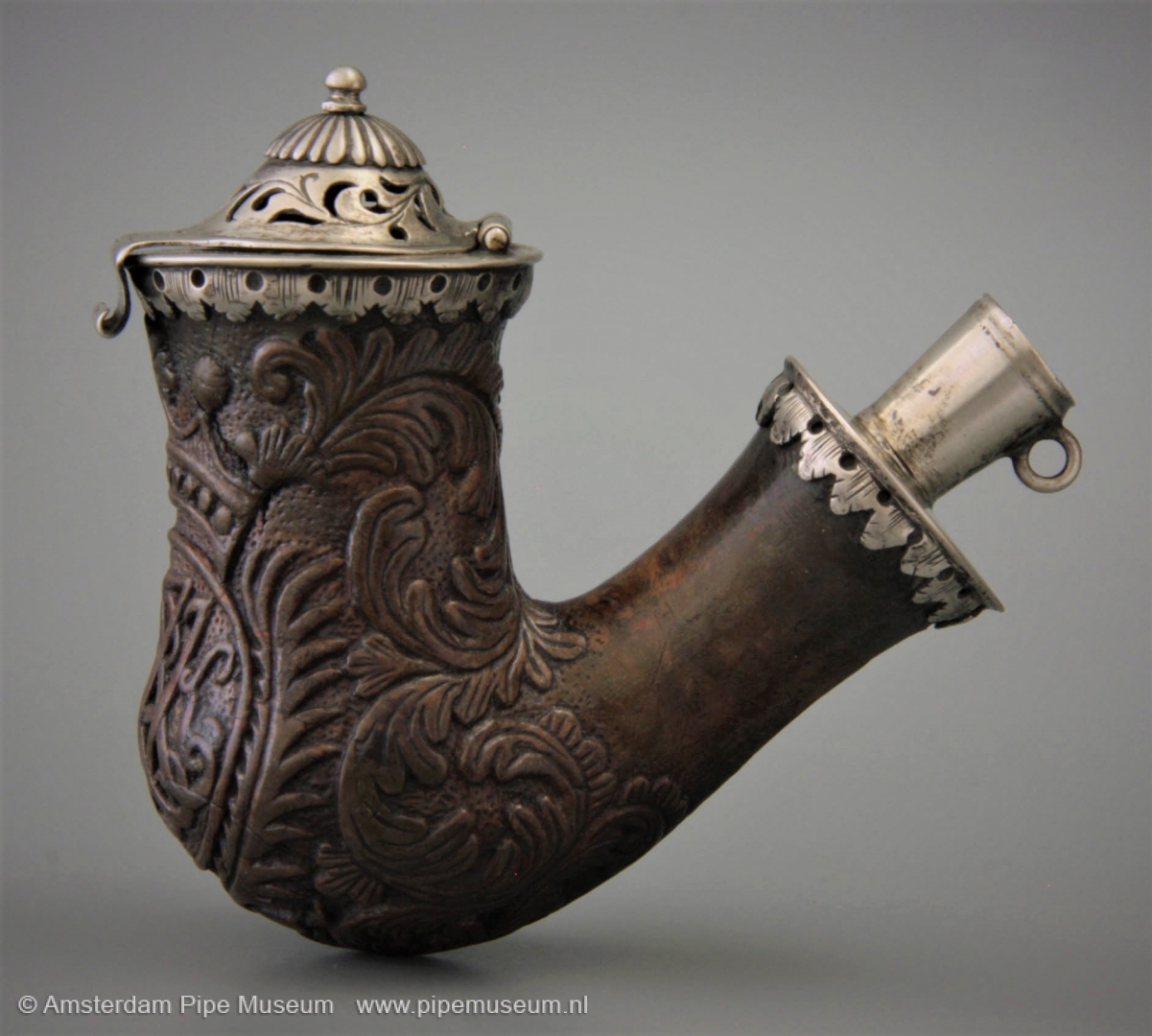
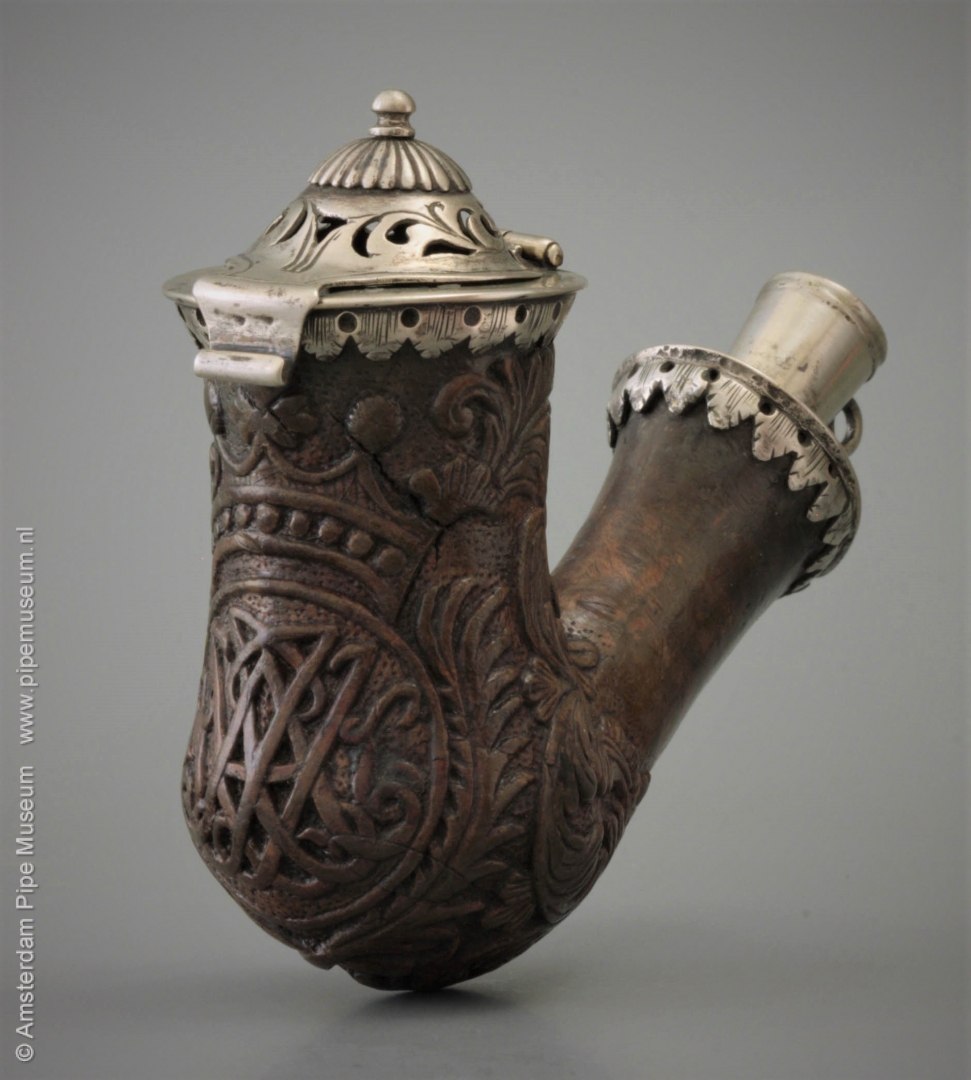
Such a beautifully carved wooden pipe was regarded as luxury smoking equipment at the time. Completely in style they were provided with a silver mounting. The hinged cover on the bowl was more or less standard for central European pipes. It’s dome-shaped cap with button on top of a circle of flowerlike lobes, shows asymmetrical openwork sawing. The stem end has the same silver fitting, which gives greater strength when mounted on a separate stem. A locking eye serves for secure attachment to this detachable stem. Both mountings are fixed with a sawn edge of leaf motifs, that fold over the wooden bowl. In order to appear true to nature, these leaves are engraved with a few engraving stitches.
Given the skill of the carving, this is a regular product, made in series by a pipe maker who understood his métier. Because of the mirror monogram, however, it appears to be an object with a personal accent, made on special request. This monogram does not have to be from the smoker himself, who ordered the pipe. It also happened that a pipe was donated as a gift and that the initials of the donor were carved out. In both cases, however, it is the monogram of the client. The person behind the initials will never be traced.
It is difficult to assign a date to this pipe. The shape was already developed at the beginning of the eighteenth century, the mounting seems to be of a somewhat later date. That could argue for a date between 1730 and 1750. Based on the fact that the pipe industry was often very traditional, such a pipe bowl could even have been made up to fifty years later. Yet it does not seem that way, because in that case, inevitably, a few later style features would have crept into the decoration. We assume that the place of production must have been in Germany, although it is not possible to specify where.
Amsterdam Pipe Museum APM 16.716
Royal portraits from Swabia
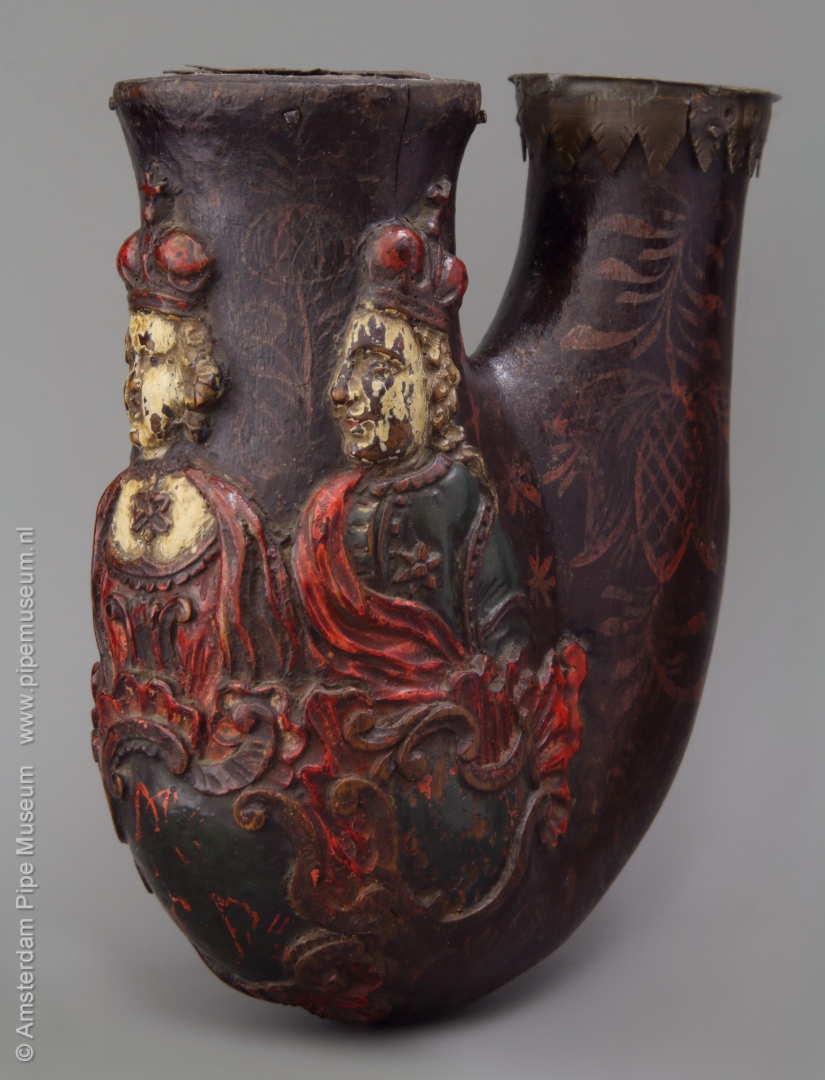
A special object is this early wooden pipe bowl. In terms of shape, it follows the pipes from the Ulm region, characterized by a high bowl that appears to be flattened because a keel passes along the bowl, extending along the bottom to the stem. The size of this specimen ís extraordinary, because with a height of seventeen centimeters, this is really a handful. Moreover, no burl wood was used, but a much softer and lighter type of wood with a less attractive grain. That might be the reason the pipe bowl is completely painted.
It is remarkable that a both eye-catching and popular decoration of three royal portraits has been applied. Pontifically up front Empress Maria Theresia, depicted looking up, the two men at her side look in the same direction and are therefore depicted in profile. Below the portraits, three cartouches are carved in light relief with clear rococo C-volutes closed with shell motifs as a frame. The symbols of the depicted are painted in the shields: the MT monogram in front followed by the R for Regina for queen, the F for Francis and the J for the son are unfortunately illegible. The carved figures are painted in red, blue and cream white. In this way they contrast against the dark brown background, which is not the natural color of the wood, but is painted like that. The stem is not carved but has a simple ornamental painting of branches with leaves and shaded fruit shapes, the free space between the bowl and stem shows stars.
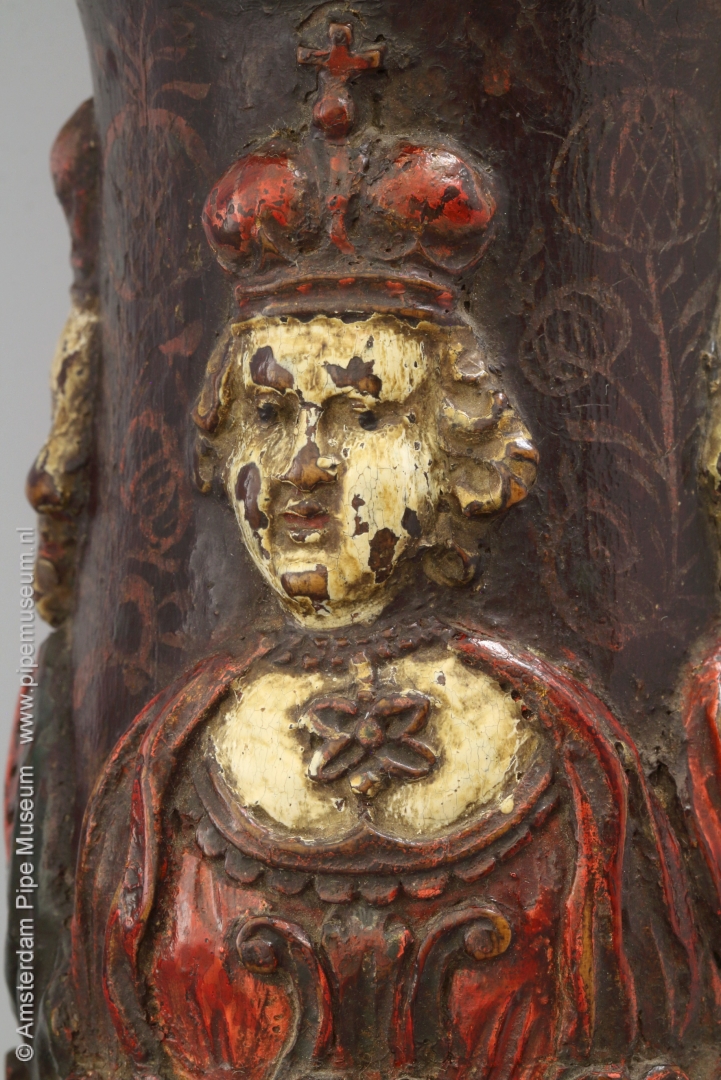

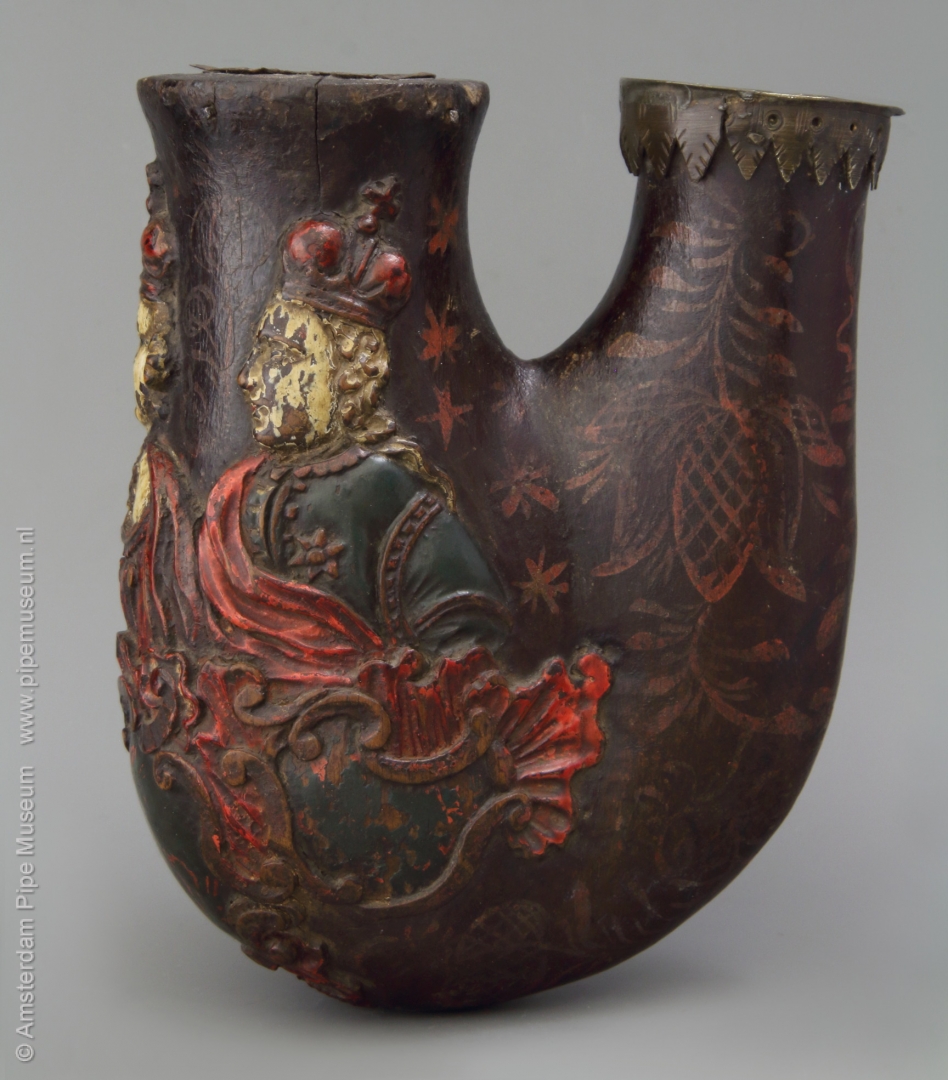
Maria Theresia as the first female monarch in Europe is often depicted with her husband Francis I. When he was crowned emperor of the Roman-German Empire in 1745, she had been queen of Hungary and Bohemia alredy for five years. She was allowed to add the title of Empress because her husband became so important. The son of this royal couple is Joseph II. He was again the first to combine all the titles of both his parents: he was therefore both emperor of the Holy Roman Empire and king in Hungary-Bohemia. He must be the third person on the pipe.
The pipe dates from the time when Joseph II was already emperor, so after 1765, the year of his father's death. Because his mother comes first, we may assume that she was still alive, she survived her husband and died in 1780. So this pipe should date between 1765 and 1780 and more probable at the end of this period. Josef was a boy of nineteen years old when he took over the imperial title. However, the portrait depicted is clearly an older person. We can only guess about the reason for making this pipe. That could even be the death of the empress and then she is up front out of honor.
The folk-art character of the object means that the iconography does not have to be so precise. The portrayal of the royals is not so much realistic, but rather symbolic. The crowns, for example, are by no means the real crowns of their countries, they are very recognizable and are even known by their own names: the Stephen's crown, the Wenceslas crown and the Reich's crown. Here, however, we see three equal king crowns of the general type. For the common man this is enough to underline their royal or imperial dignity.
As usual with softwood pipes, the bowl and stem are internally lined with sheet iron. This was necessary to guarantee a lifespan. In that period, the second half of the eighteenth century, such pipes were fitted with a brass plate mounting with a hinged cover and stub plate, usually provided with simple engravings. Only the stub plate has been preserved and shows an eight-pointed star, the rim around the stem is serrated. All in all, this pipe is a rare example of princely worship in an early folkloric Ulm shape.
Amsterdam Pipe Museum APM 24.019
Stylish panache with carpenter's tools

The depicted pipe is not only special because of the beautiful carvings on four sides, but mainly because the four-sided bowl makes a remarkable s-curve, which gives the pipe a swing in a vertical line. The actual straight shape of the rectangle is softened by the elegant curvature on the one hand and the acanthus leaves along the underside on the other. Together they indicate that the pipe originates at the transition from rococo to Louis XVI style. The three bows also fit in well stylistically. We are then talking about the period 1770 to 1790.
Various types of carpenter's tools hang from the ribbons on the three surfaces. It is no coincidence that all tools are symbols that play an important role in Freemasonry. This makes this a Masonic pipe, full of deeper meanings. The main and most famous symbols are on the front: square and compass with the sculptor's hammer. With these tools the Freemason forms a rough piece of stone into a perfect cube, in a metaphorical sense he brings his own person to perfection. The square with its fixed angle stands for the material, the compass with movable legs for the spiritual.
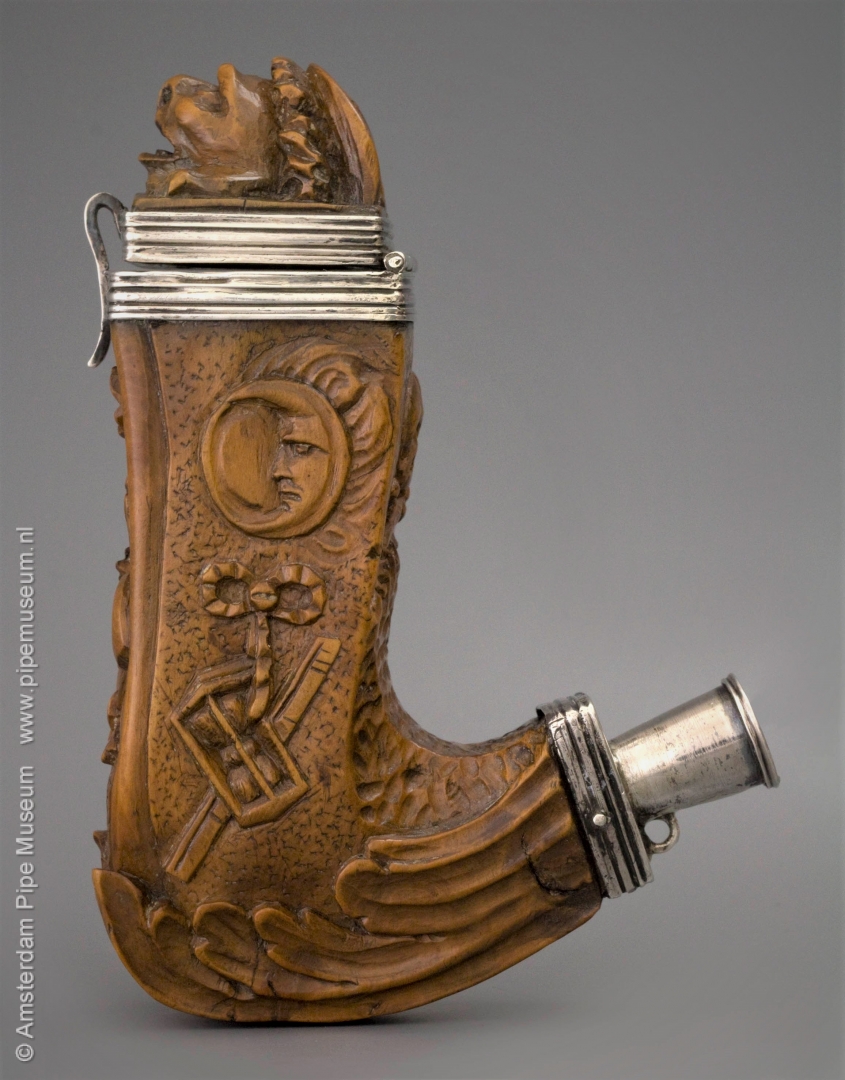
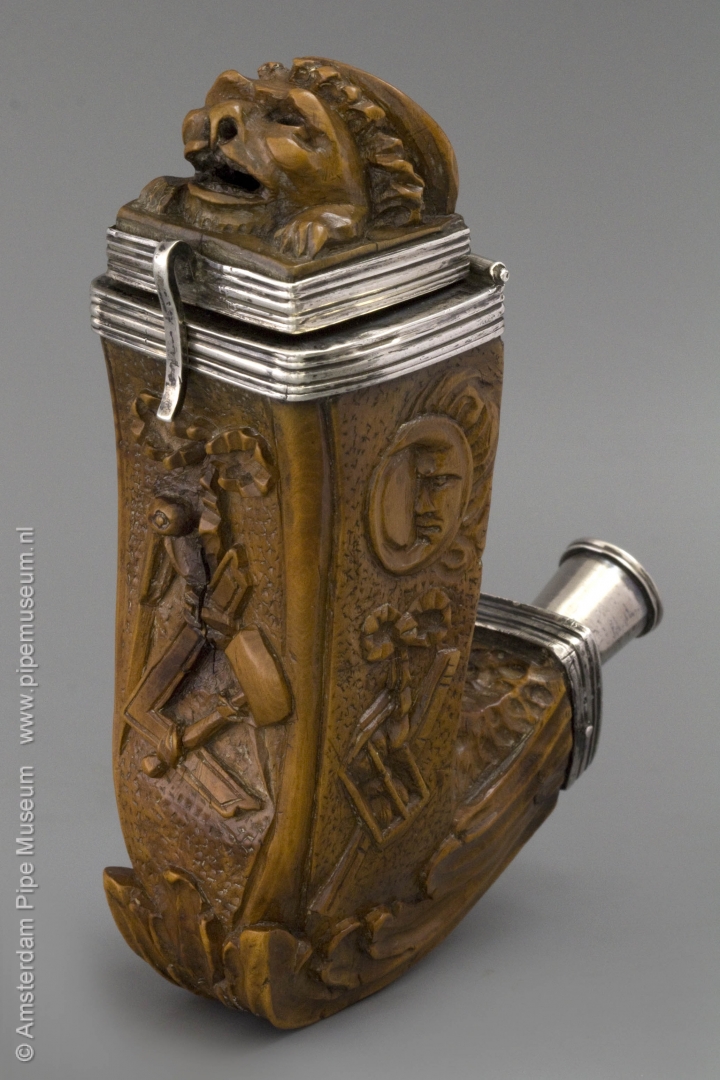
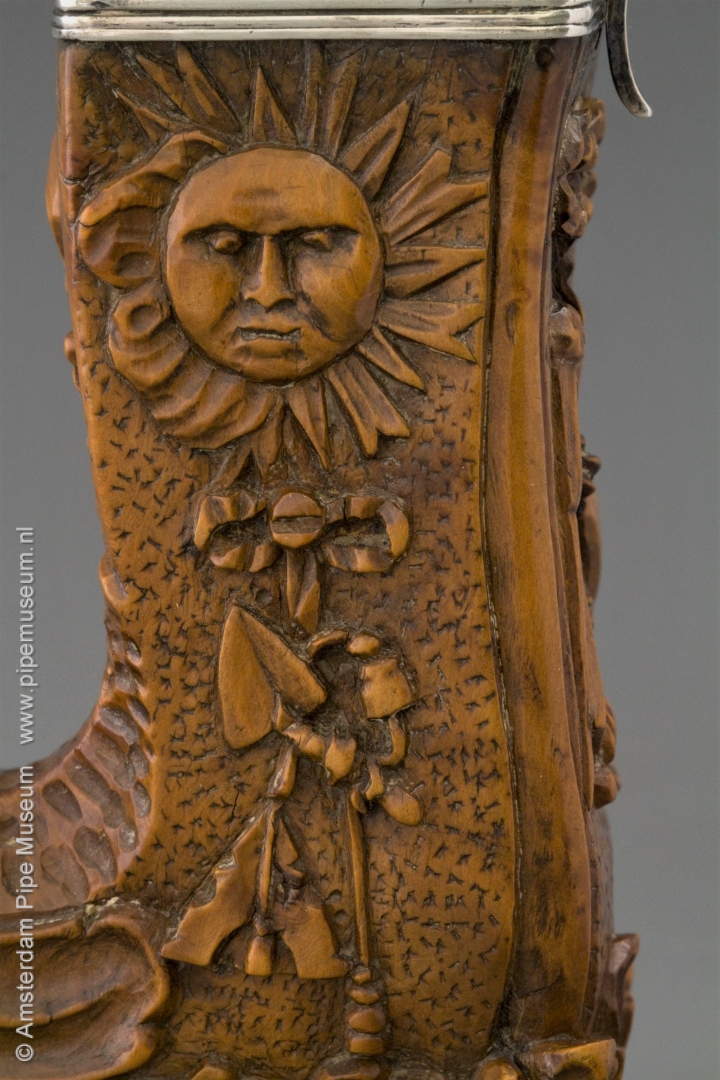
On the right side we see under a radiant sun, a symbol for the active light, a trowel to apply the cement between the members and a plumb bob on a knotting cord. On the left the crescent moon of passive light is depicted, followed by a ruler and hourglass, also on a ribbon with a bow. The stem side is filled with a heap of sand with a skull with shanks. This memento mori that the smoker looks at reminds him of the mortality of man. The carving is efficient and refined, you could say in contrast to the depicted tools of an ordinary carpenter. However, the high-quality work is very suitable for a venerable group of Freemasons.
The pipe bowl has its original silver mounting with a square hinged cover with a simple closing spring. On top, a wooden insert with a lion's head has been placed, adding a playful element to the pipe. The lion's mouth and nostrils are the only air supply for the pipe bowl; if the smoker does not pull on the pipe for a moment, smoke curls out of the lion's mouth. This part of the carving seems older, but that is a misguidance; it may be because the head has turned brown by the smoke. The stem is assembled with a square stem plate on which a conical stem holder with a small locking eye. As usual with softwood pipes, the bowl and lid, but even the stem, are lined internally with sheet iron. This is to prevent the pipe from going up in fire after a few smokes. However, if you look closely you will see that the fire has already leaked through the iron cladding on the front of the bowl. For the smoker, that announces the end of the pipe. The pipe has not been smoked since then.
The unique shape with the special swing and the refined carving make this pipe bowl a special piece. Freemasons usually like to surround themselves with all kinds of objects with the masonic symbols, but at this moment no second wooden masonic pipe is known.
Amsterdam Pipe Museum APM 22.820
Fantasy portrait man with three sided hat
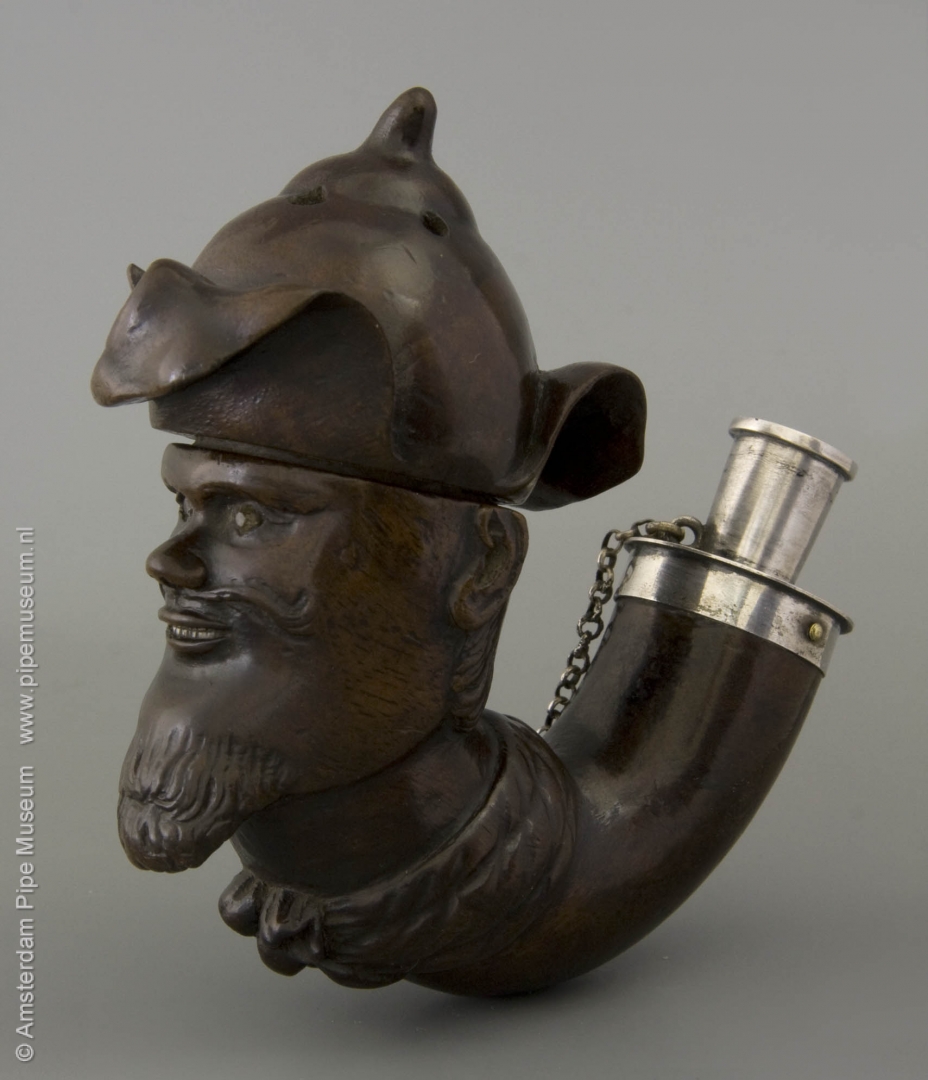
This pipe bowl dates from the period between 1770 and 1820, despite the fact that some toned down features of the Louis XV style are still visible. The hat with the flamboyant wavy brim, in particular, is vaguely reminiscent of the Rococo elegance. Another characteristic of early period portrait pipes is that details in different material are added. Here the eyes are filled in with glass and the teeth carved from a tiny piece of mother-of-pearl. Such unexpected accents make the face lively and articulate, making it instantly more expressive. At the same time, these playful additions create a kind of folk art style.
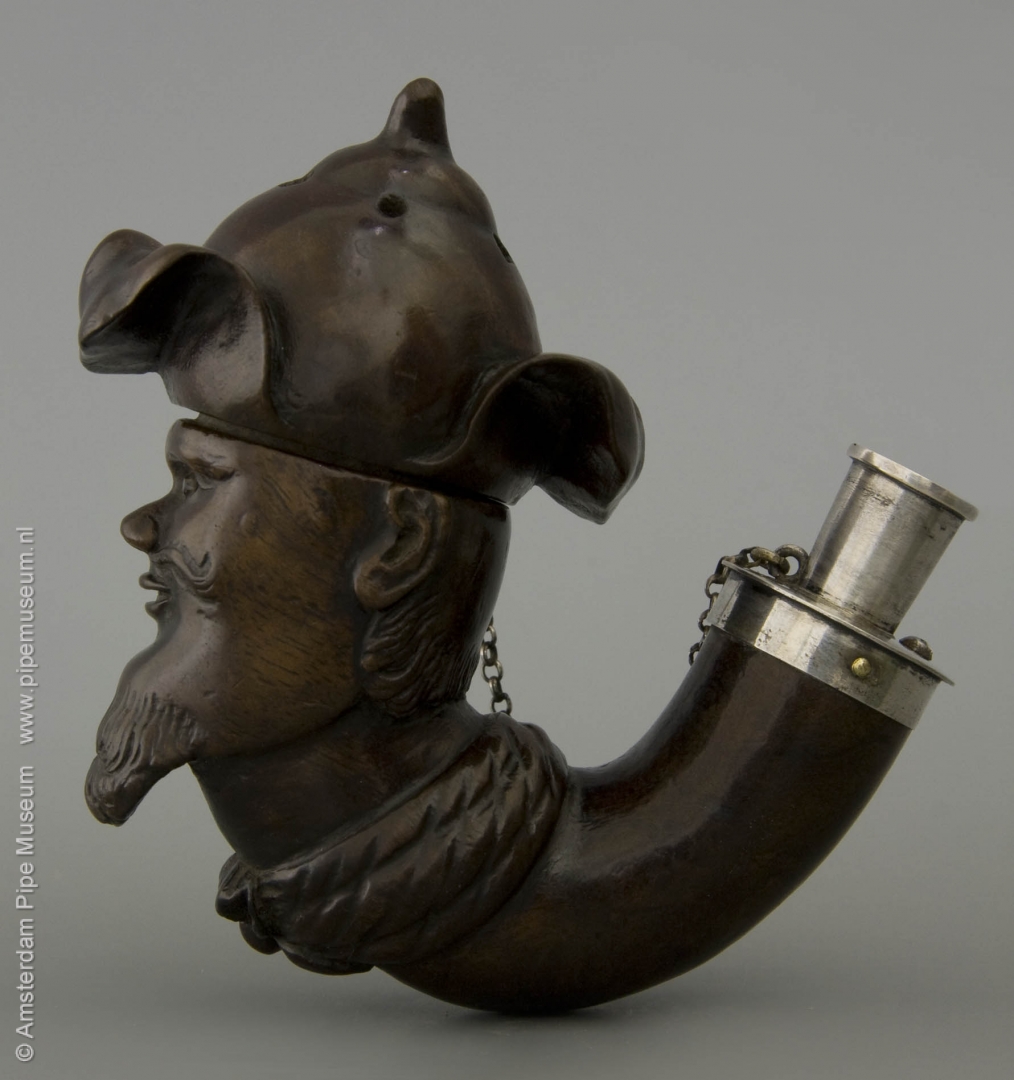
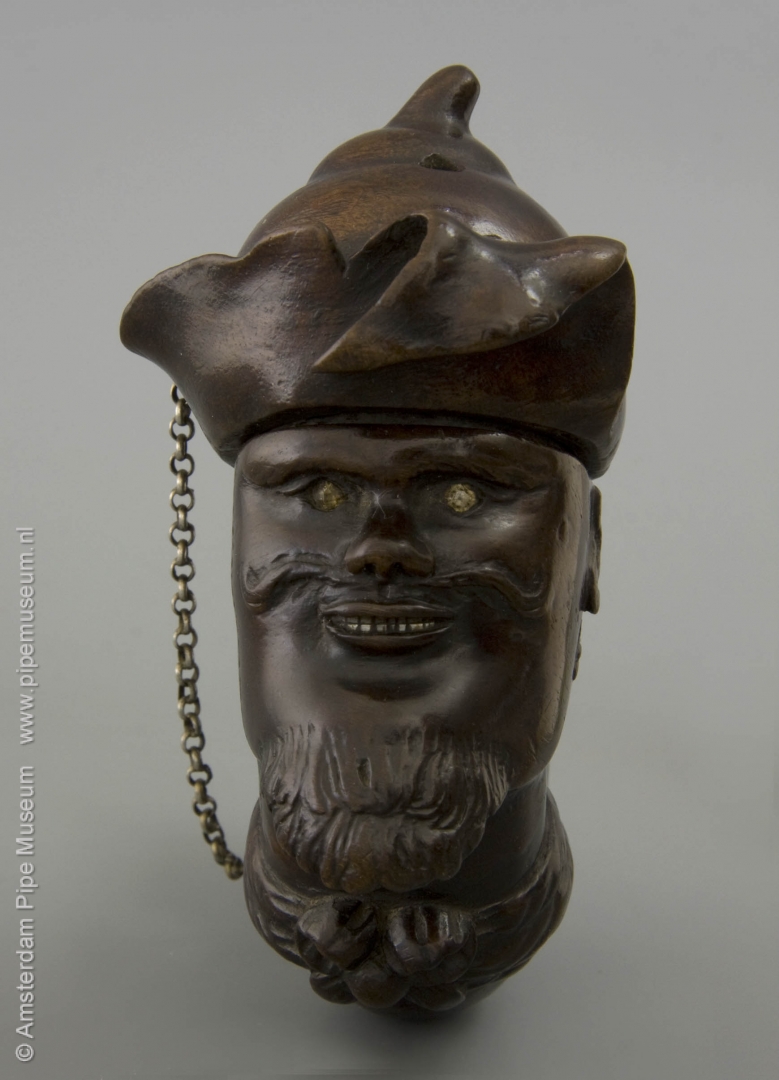
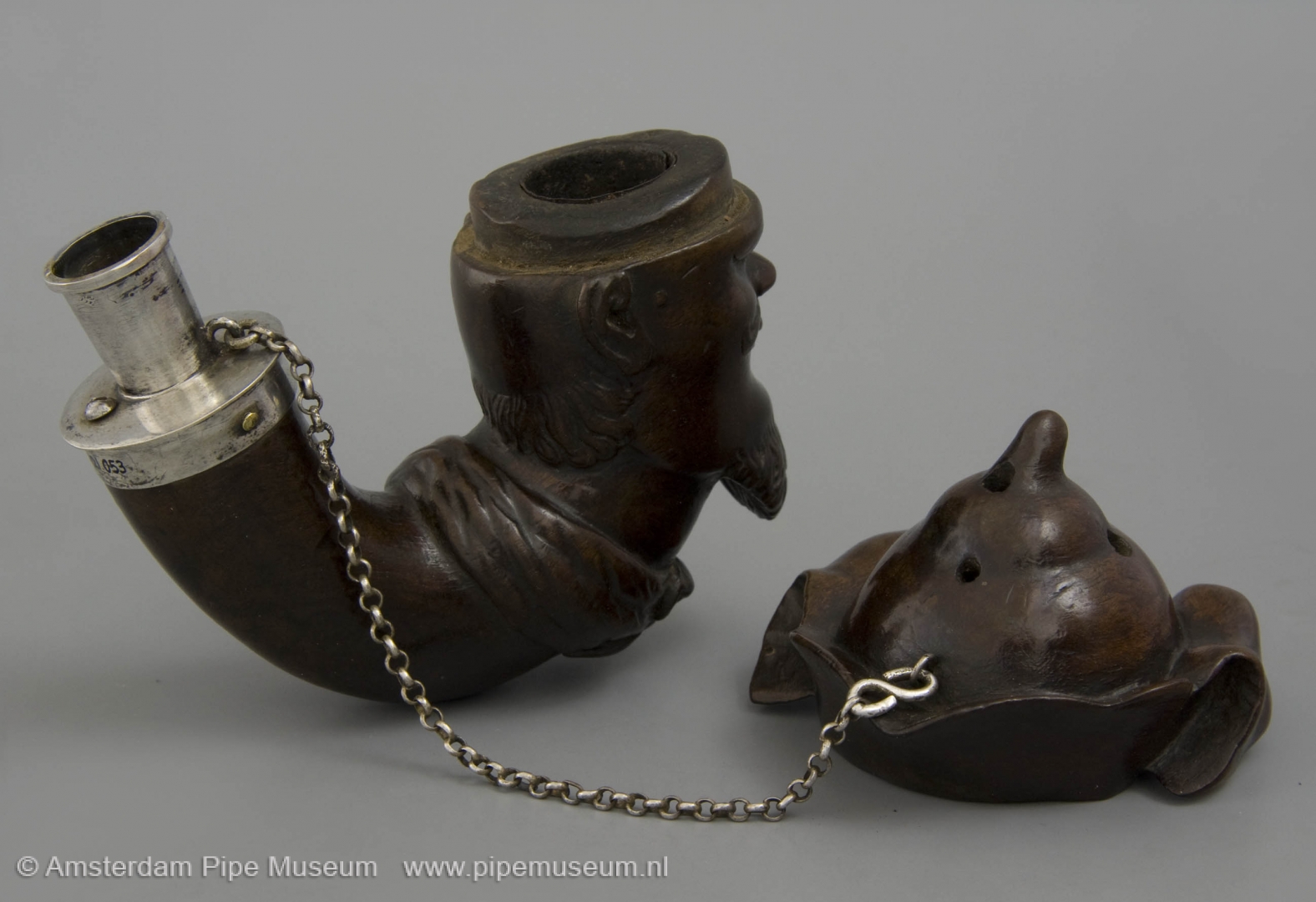
The representation of the man with a small mustache, goatee and tonsure on the back of his head is certainly not the picture of an existing person. His hemispherical hat with a bent point and three whimsical curled brims indicates a jester's hat missing the bells. His cheerful face with a smiling open mouth fit in with this. His cap is secured with a silver chain, fortunately so well that this important part has been preserved with the pipe. As a mark between the bowl and the stem we see a simple knotted scarf with a bow on the front. As usual with softwood, the pipe bowl is lined internally with sheet iron. The stem end has a silver mounting with stem holder and locking eye. In this case this silver is attached to the wood with extra nails. It proves that mounting was still a struggle for the maker; he wanted to be on the safe side.
At the end of the eighteenth century, chic porcelain pipes were in fashion, often designed as fanciful, sometimes even commedia-del-arte portraits. Such a pure design porcelain portrait pipe probably served as an example for this specimen, but this is not verifiable. The carving is quite cleverly executed, it is very personal although not really artistic. It seems that the carver was able to work out every part well, but the overall coherence has not become really convincing. That is what makes this portrait head so intriguing. As a product it fits in a series of similar heads, which are very varied in appearance. Together they write the history of the early wooden portrait pipe, which parallels the porcelain design but is less exclusive and therefore much more affordable for the smoker at the time. Due to the vulnarability of the material, very little of the softwood pipe has been preserved. This rarity factor is what makes dating and provenance so difficult. Switzerland may be more likely to qualify as origin than Germany.
Amsterdam Pipe Museum APM 21.053
Coat of arms of the French royal family
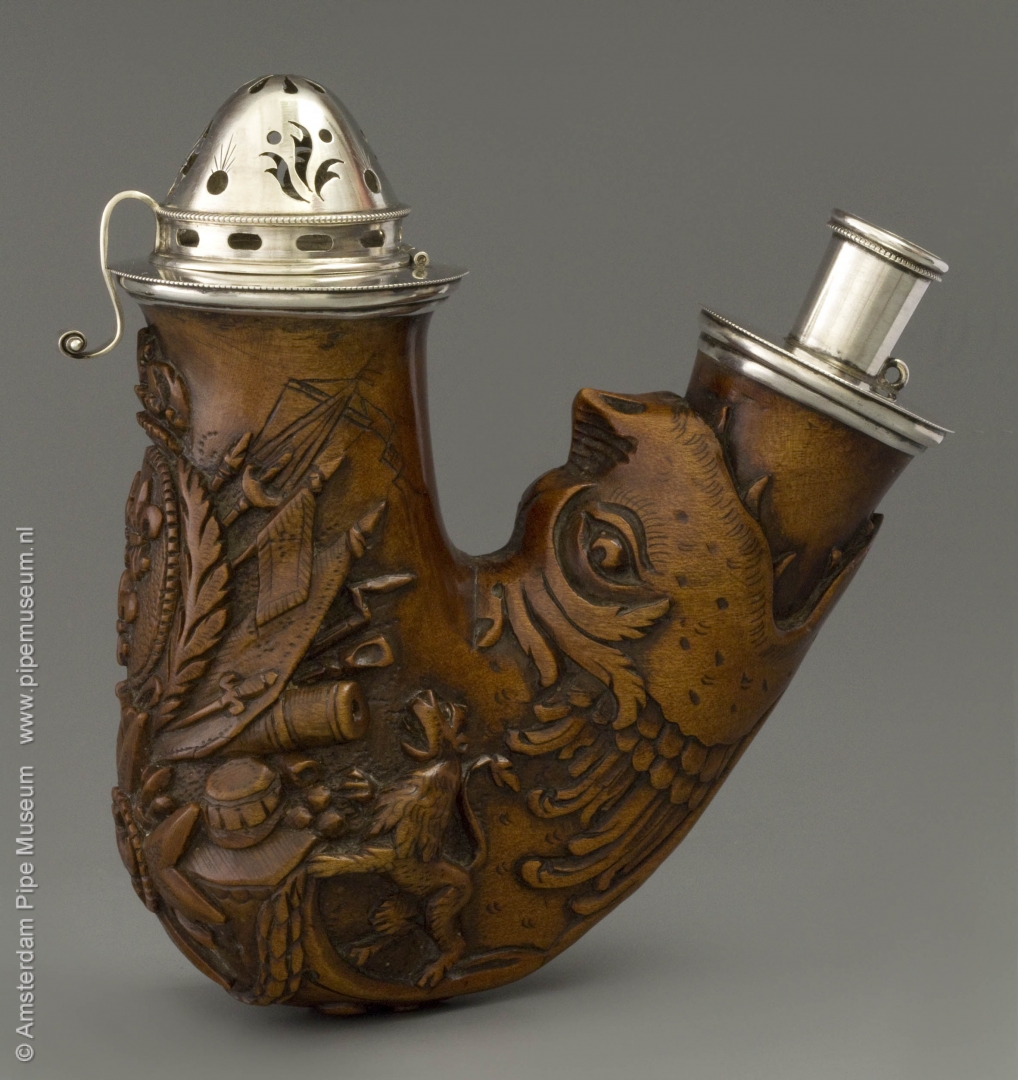
The production of Ulmer kloben, beaker-shaped wooden pipes with a keel along the bottom, has been an important activity in the area around the town of Ulm with successful sales to all directions. Inspired by the German Ulm pipe, similar products have been produced elsewhere, copied from the Ulm type, but with local characteristics. This mainly happened in eastern direction, towards Bohemia, the present-day Czech Republic up to far into Hungary. Here is a much rarer example from French soil that is decorated with a very French theme, namely with the coat of arms of the King of France.
At the front of the bowl an oval heraldic shield between leafy branches holds three French lilies, the famous fleurs-de-lys under a crown. Below it is the sign of the Order of the Holy Spirit or Saint-Esprit, a four-armed Maltese cross with four lilies in between and a central dove. An extra French lily has been added to the bottom of the bowl. These heraldic motifs are impressively complemented by weaponry arranged along both sides of the shield. Flags, lances, cannons, drums and more has been carved in two rows with the top of the ship's masts engraved with a flapping vane. Even further away, at the base we see a small standing lion on either side. This decoration is arranged in a particularly tasteful manner and all parts are clearly recognizable because they have been expertly cut.
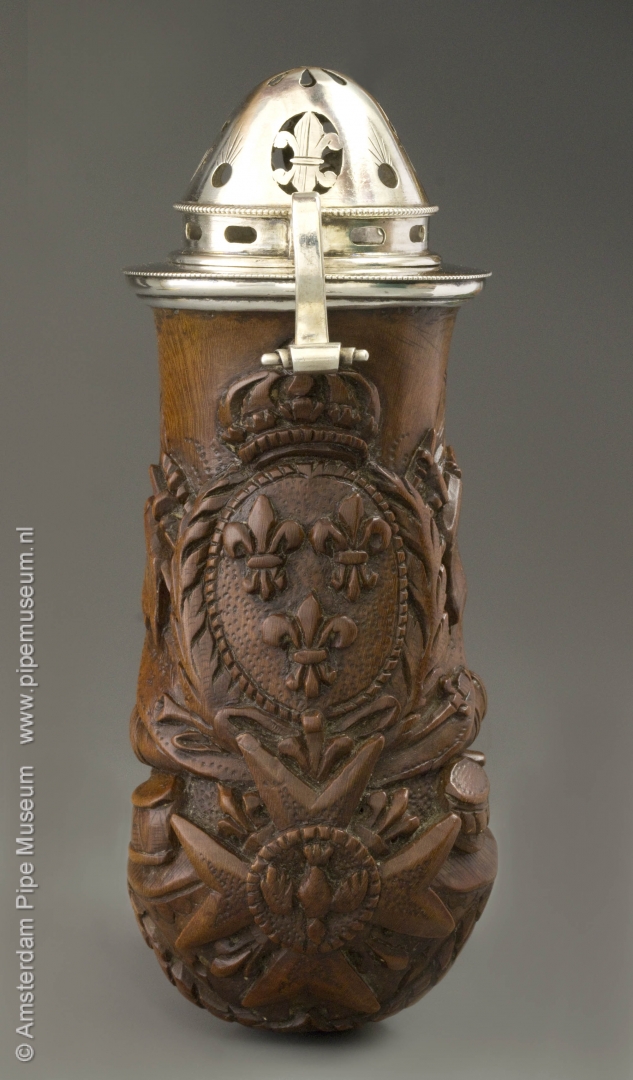
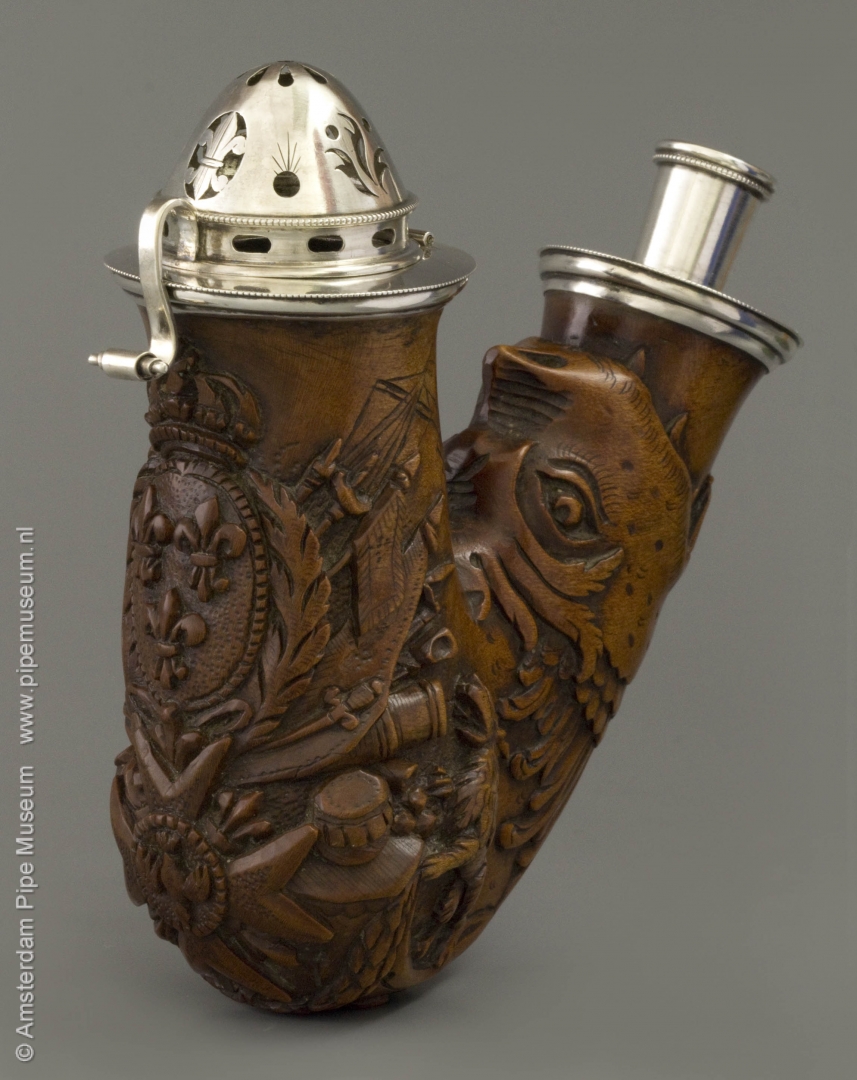
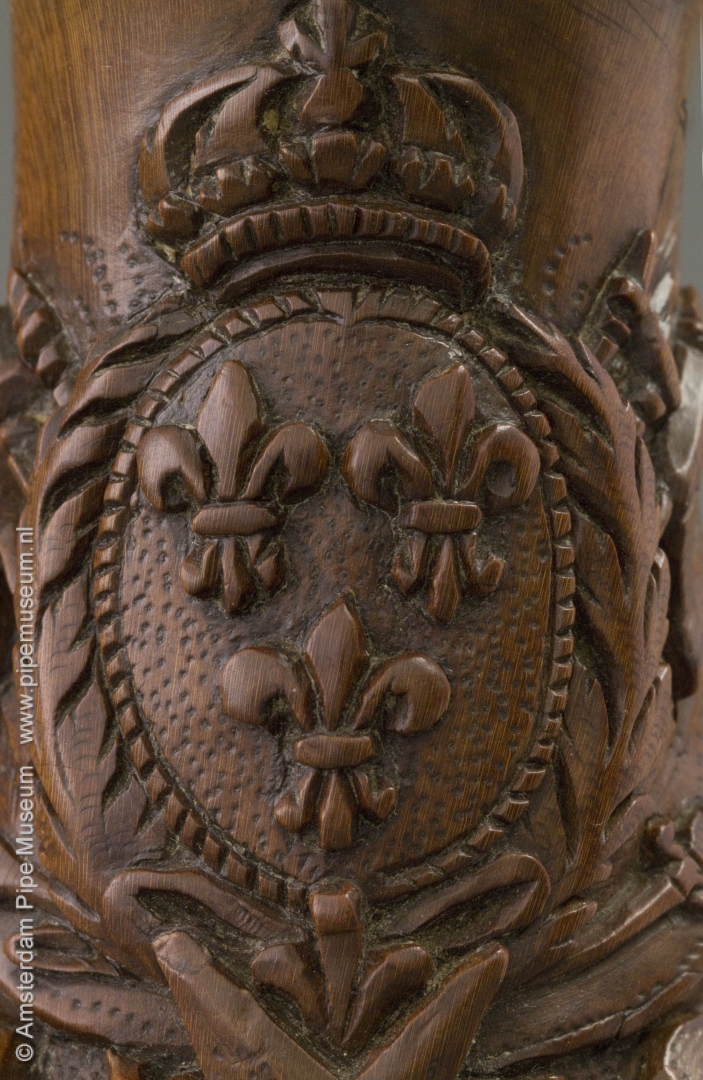
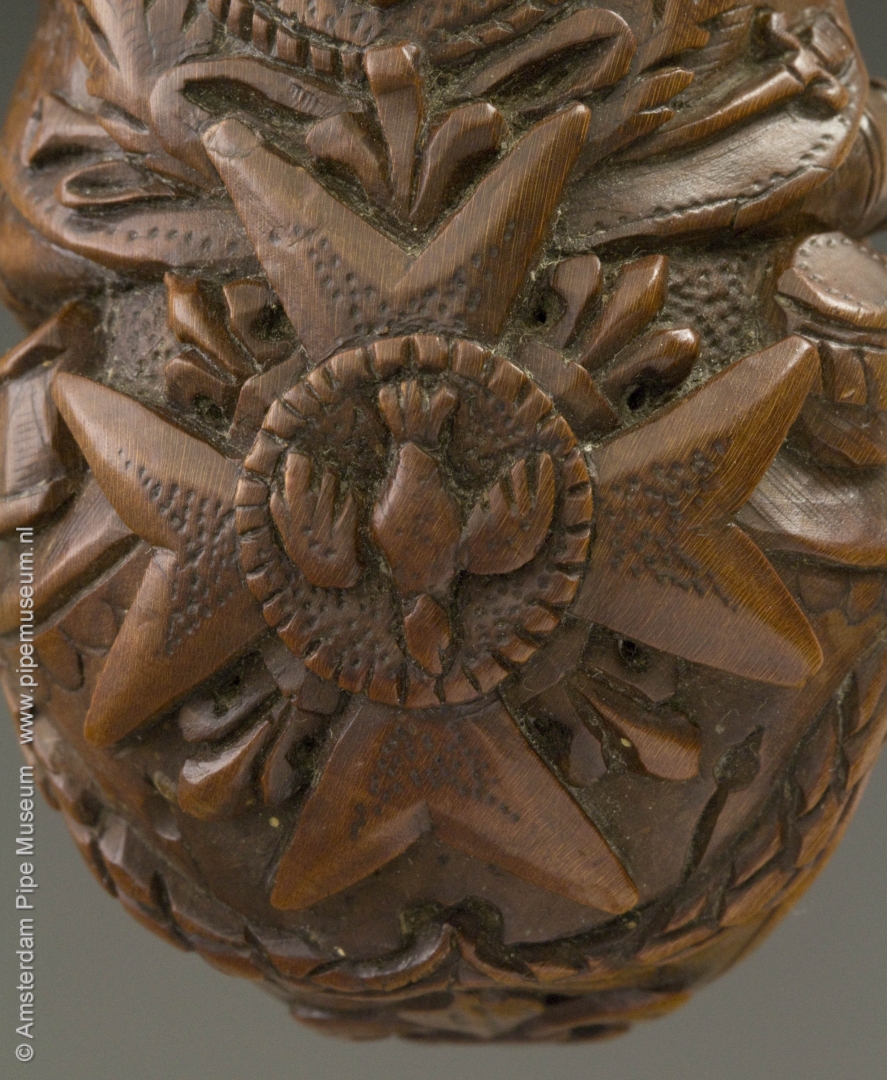
Remarkable is the decoration on the stem, which is clearly copied from the Ulmer pipes. Shown here is a stylized fish head with a wide open mouth at the stem end. We know this motif from many decorated Ulm pipes. Fish has been of great importance since the Middle Ages, especially due to the strict tradition of fasting whereby fish was permitted. Ulm, situated on the Danube, has an important tradition of catching river fish such as salmon, sturgeon and barbel. However, the French carver made his own interpretation. For example, the head of the animal is more explicit, with more relief than with German pipes. He transformed the distinctive fish scales into a kind of stylized acanthus leaves, as well as the eyebrows at the eyes. In the German examples the fish normally is diplayed in its entirety, often even including a curled tail where everything is covered with small scales. That is missing here.
The pipe bowl has its original mounting with a silver dome-shaped hinged lid with another lily cut out at the front and circles or leaf motifs all around. That mounting makes this pipe very French. Germans in the Ulm region usually cast their lids, which we notice in the solidity and high average weight. The French silversmith who mounted this pipe bowl was not familiar with these techniques. He had his own interpretation of pipe mounting. He opted for hammering sheet metal, using little silver. The results are impressive, nevertheless. The design is lustrous and powerful, while the surface is tastefully and functionally broken by sawing the air-holes. The sawn-open lily in the lid is a beautiful repetition of the coat of arms motif. He also applied a simple silver cuff mount with a stem holder and small locking eye.
Due to the appearance of a fish head with an open mouth in the stem, we have to conclude that it is an early pipe. As noted, this motif has been copied from the Ulmer pipes and has been a popular design element there for half a century. Yet that fish is no longer popular after the French Revolution. Whether that means that we should give the French pipe bowl an early date is still the question. When the pipe was made in honor of Louis XVI, it must date before his beheading in 1793. The image of the fish also points to this. However, if it is a tribute to Napoleon's successor, the pipe dates from the time after 1815 to 1830 with kings Louis XVIII (reigns 1815-1824) and then Charles X (1824-1830). Subsequently, the house of Bourbon is exchanged for the house of D'Orleans and the coat of arms will be meaningless. With that later dating, the silverware fits better, but the fish is an outdated symbol. It is therefore by no means always easy to place an object sharply in time, let alone indicate the target group of the product. In any case, it is certain that the inspiration comes from Ulm, while the execution is clearly French. It is a unique proof of how designs travel from one area to another, yet always betray if an object is not made in the place of origin.
Amsterdam Pipe Museum APM 22.648
Trophies from Napoleon
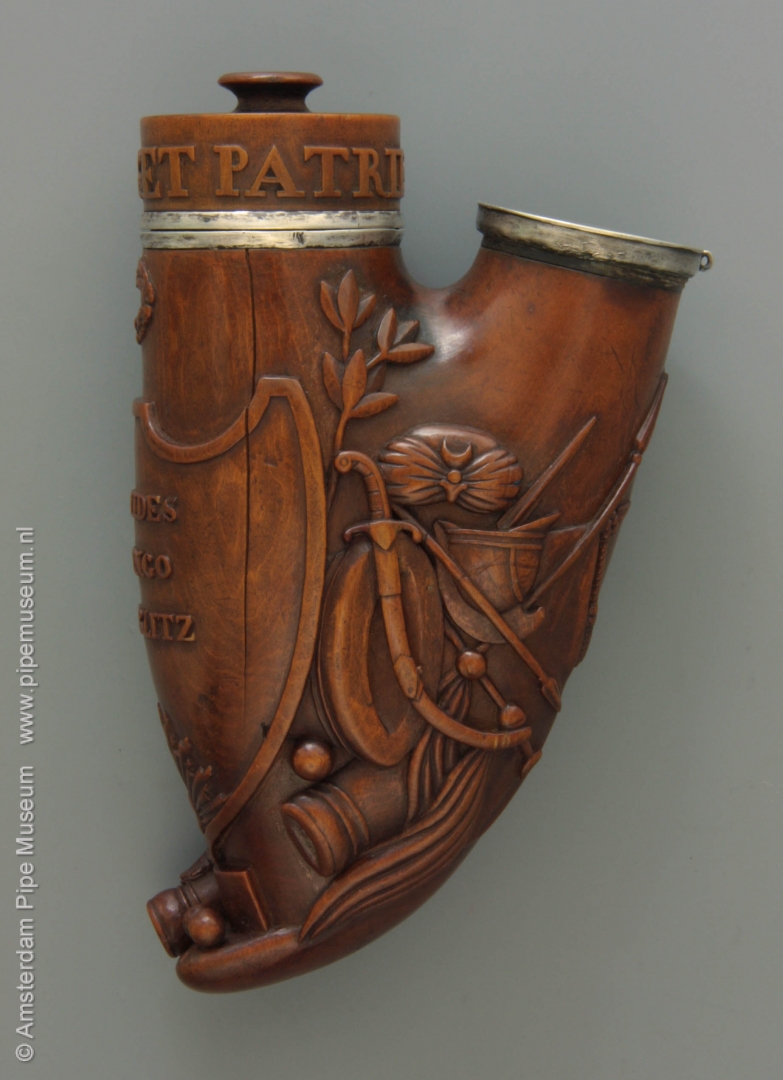
This beautiful pipe bowl made of very fine wood, possibly boxwood, is an ode to the battles of Emperor Napoleon. The object commemorates the victories of the Pyramids, at Marengo and Austerlitz, in 1798, 1800 and 1805 respectively.
The shape of the pipe harks back to the Ulm shape because of the slim oval bowl and the slightly flattened stem without a stub. At the front of the bowl we see a shield in which a radiant sun with the inscriptions PYRAMIDES MARENGO AUSTERLITZ. The depiction on the right side of the bowl is by far the most beautiful. Here we see a standing helmeted woman with a staff in her hand, the symbolic representation of Victory, personification of peace after victory. She has a sword on her belt, with her left arm raised she holds a laurel wreath above the text shield, with her foot she tramples a cannon barrel, which forms the heel marking of the pipe bowl.
The left side of the bowl shows a trophy of weaponry, continuing on the stem. In this we recognize the weapons of the vanquished Mamluks, the rulers of Egypt at the time, such as the scimitar alongside a turban with a half moon. We also see a mortar, saber, lances and more. Striking is the cylindrical wooden lid of the pipe, mounted with silver straps, with the inscription HONNEUR ET PATRIE in relief all around, the motto of the famous French Legion of Honor.
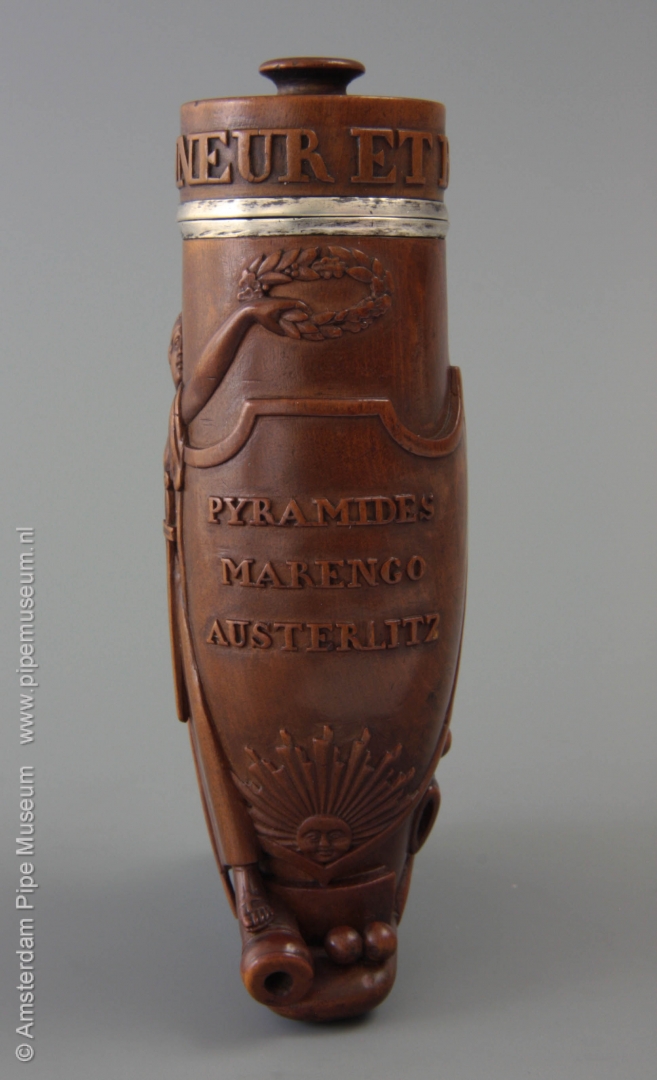
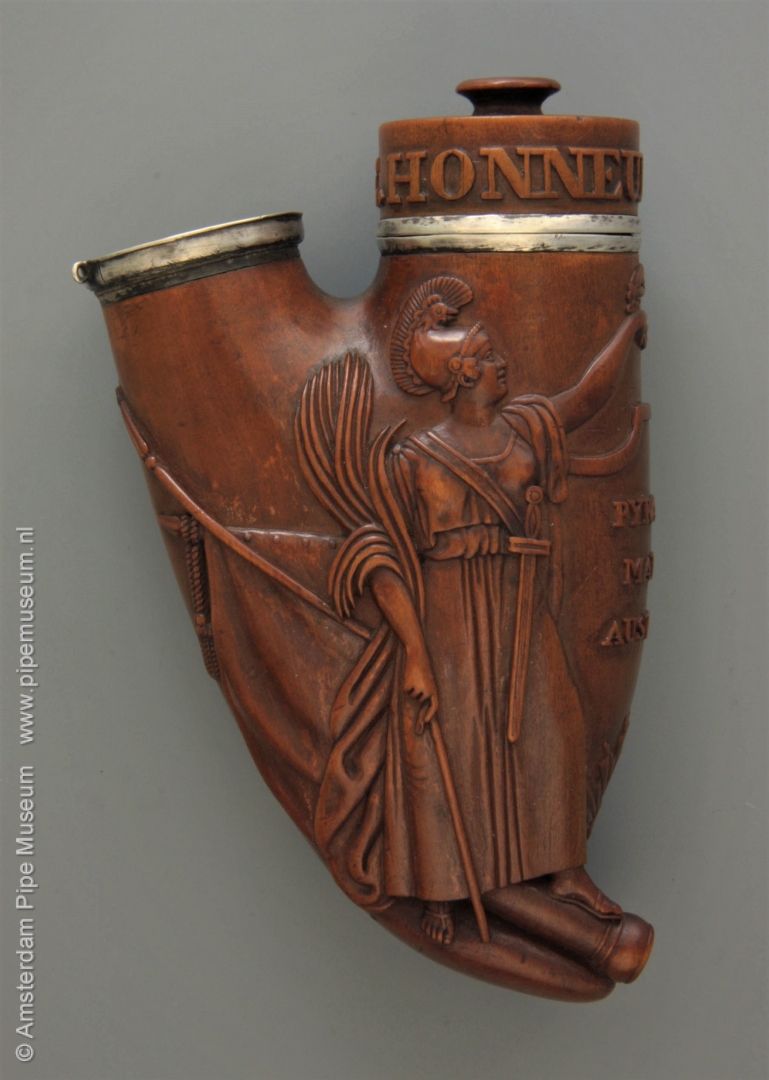
The depiction of the three battles underscores Napoleon's first major military successes. The Battle of the Pyramids took place in Egypt in 1798, while miles from the famous Pharaonic structures, but it sounds convincing. The whole expedition to Egypt was better for publicity than military. It would lead to the decipherment of hieroglyphs and a completely new fashion in the arts inspired by ancient Egypt. The second battle was fought in 1800 at Marengo in Piedmont, Northern Italy, against the Austrian army. This narrowly won battle was also exploited by Napoleon as a great success, especially because it was his first battle that he fought as consul after his seizure of power in 1799. He named his famous white horse Marengo after this battle. The Battle of Austerlitz in today's Czech Republic in 1805 was a battle that established Emperor Napoleon's reputation as a genius strategist. The coalition army of Austria and Russia had to admit defeat contrary to expectations.
Apart from struggles in Spain and some colonies in which Napoleon himself did not participate in person, he is present as a victor in the years that follow: 1806 Jena, 1807 Eybau and Friedland against Prussia and Russia, 1809 Eckmühl and Wagram against Austria. Since all these victories are not mentioned on the pipe, we may assume that the object dates from the short period starting 1805 until October 1806 at the latest. For a handcrafted product, this is a very accurate dating, supported here by the historical battles. We can also say that this pipe was made for an ardent supporter of Napoleon in the early days of his reign. Too bad we don't know exactly who owned this pipe.
The fact that this pipe dates from the Empire period is also clearly visible in the carving. As a luxury item, it displays the classicistic features that were almost worshiped in that era. We see this not only in the austere, but not strictly symmetrical design, but also in the details, such as the pleated robe of the woman and the way in which the elements are spread over the pipe bowl. The pipe thus radiates a chic academic atmosphere.
Amsterdam Pipe Museum APM 19.819
Turkish battles in folk style
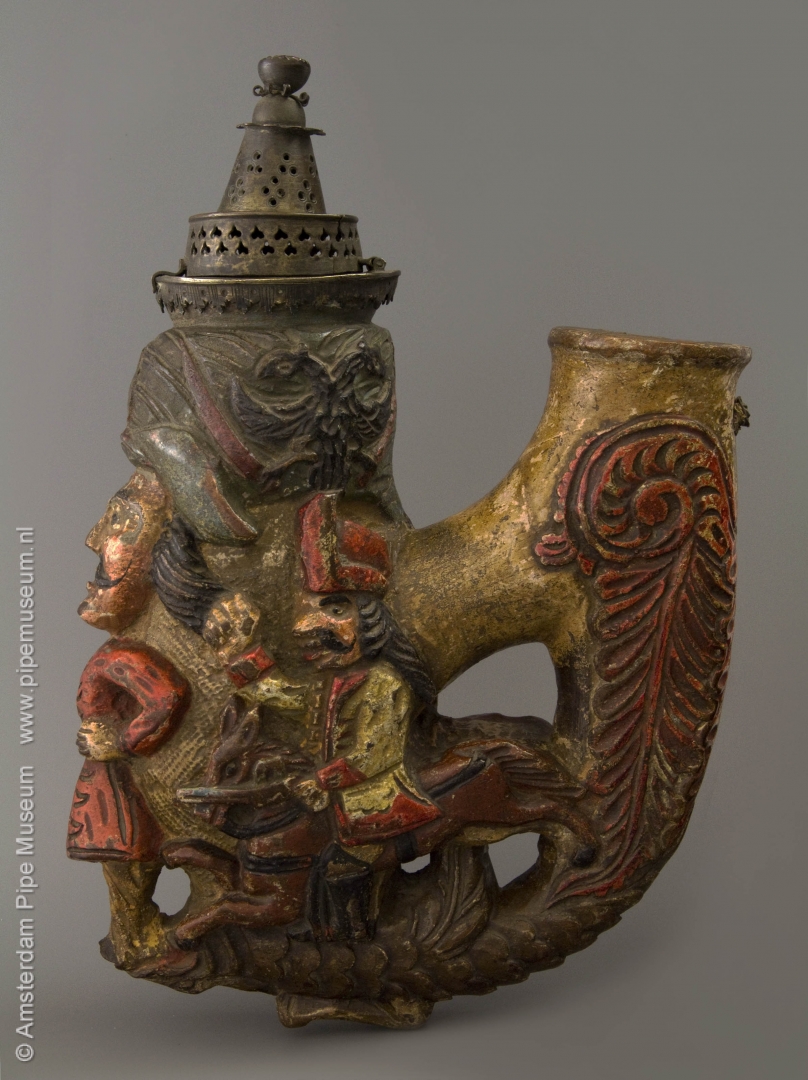
This wooden pipe bowl is remarkably large and showy in design. The distinctly folk-art carving around the bowl shows a standing figure in front flanked by two horsemen. The standing man turns out to be a Turk with a mustache and half-long hair, dressed in a red tunic with a turban embellished by a crescent moon. He holds a scimitar in his raised right arm, his left hand on the belt. On either side of the bowl the scene continues with a rider on horseback, on the right with shoulder-length hair, a bicorne on the head and a curved saber in the raised left hand. The rider on the left wears a hat with a feather and holds a revolver in his left hand. Above the two horsemen we see coats of arms that identify the depicted. Along the bottom of the pipe bowl is a dragon with a protruding tongue on which the Turk at the front of the bowl is standing.
In its large, bombastic version, this is a bizarre pipe bowl. Remarkable, for example, the inferior light type of wood, which is doubled with sheet metal on the inside of the bowl against burning. A kitschy aspect is also the hinged cover with a conical tower shape made of brass, with ventilation holes. On top of this cap is a mounted polished red glass ornamental stone which should give the impression of a ruby. Also pay attention to the beautiful, finely sawn edge with which the lid rim clamps around the pipe.
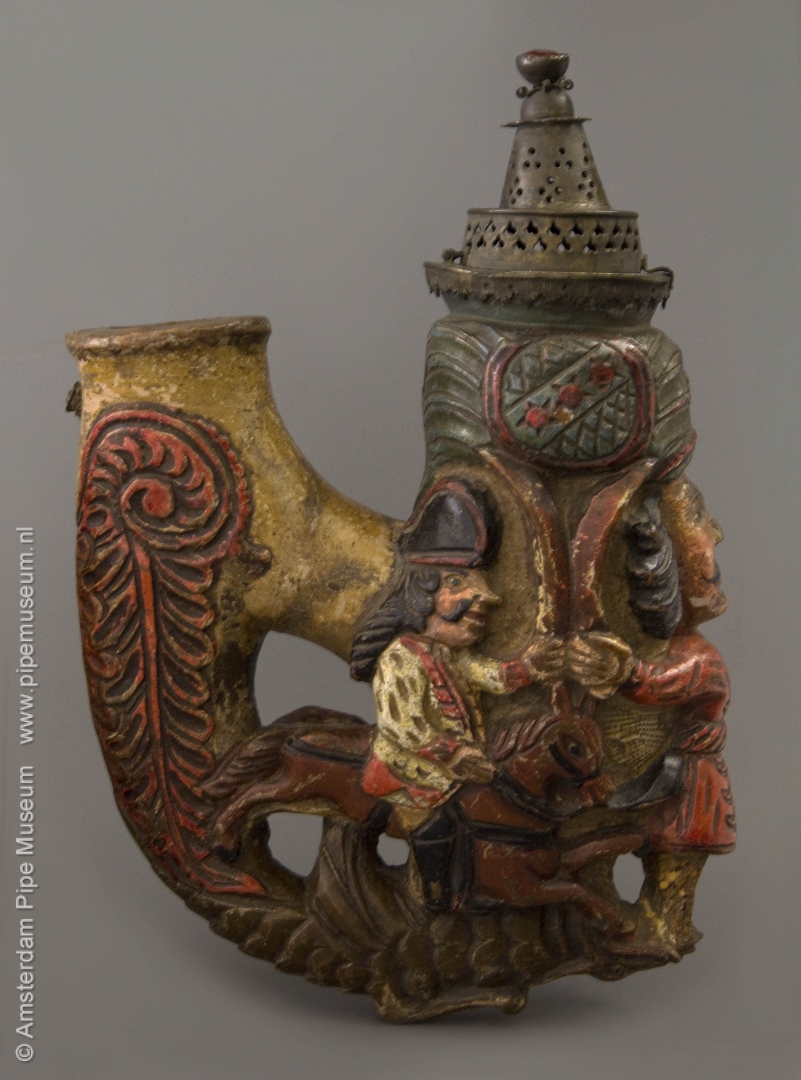

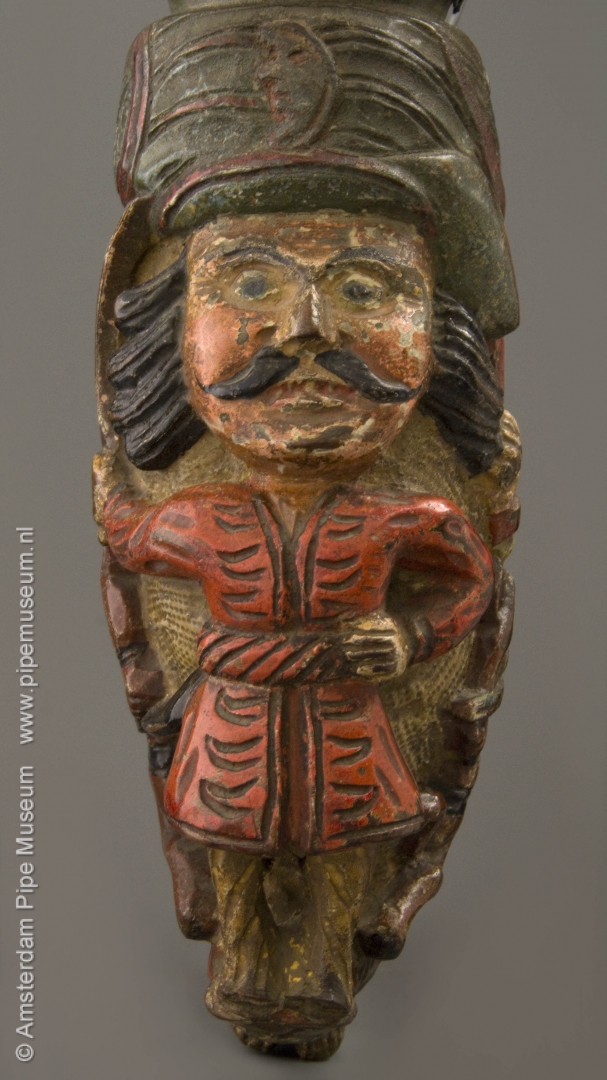
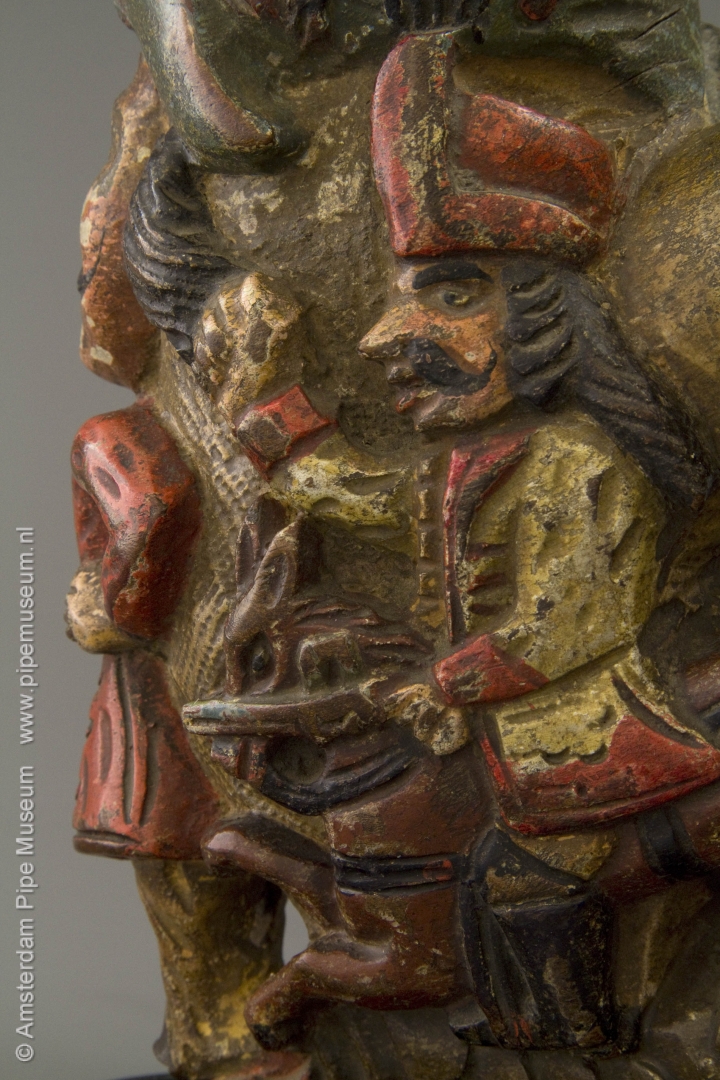
Finally, there is the finish in bright primary colors that have been painted onto the surface. They emphasize the folk-art character, but at the same time they help to interpret the scene. The horsemen on both sides wear a white, red-trimmed coat, which is the hallmark of the uniform of the Imperial Army, that of the Holy Roman Empire. This army fought the Great Turkish War against the Ottoman Empire from 1683 to 1699. In front of the pipe we see the opponent, a Turk in typical costume with a turban and scimitar. Above the rider on the left with his pistol we see the coat of arms of the German Roman Empire, the black double-headed eagle with a scepter and a sword in its claws. The rider on the other side is depicted in connection to a relatively unknown coat of arms with three stars in a slanted bar. This is the coat of arms of Leipheim, a small town in the north of Bavaria, in the former Swabia. This area once fell directly under the authority of the Roman Emperor. It is known that this was one of the German principalities that sent soldiers to the Great Turkish War who actively fought there.
Although the pipe dates from a later time, it certainly refers to this important war, which at the time banned Islam from Europe. It would have been close to the Ottomans taking Vienna in 1683 and thus overthrowing the Habsburg Empire. It is therefore not inconceivable that a hundred years later this historical period was still actively commemorated. With the defeat of the angry Turk the dragon was defeated, as it were. Even simple smokers in Hungary and Austria understood the scene.
The origin of this pipe must lie in Hungary, although some sources speak of a Swabian pipe. The date is probably around the year 1800, so it is not a contemporary depiction but a commemorative piece. It is difficult to interpret the target group. Such a folk and bombastic tobacco pipe with a moderate function must above all have been a showpiece.
Amsterdam Pipe Museum APM 22.570
Bird with two heads
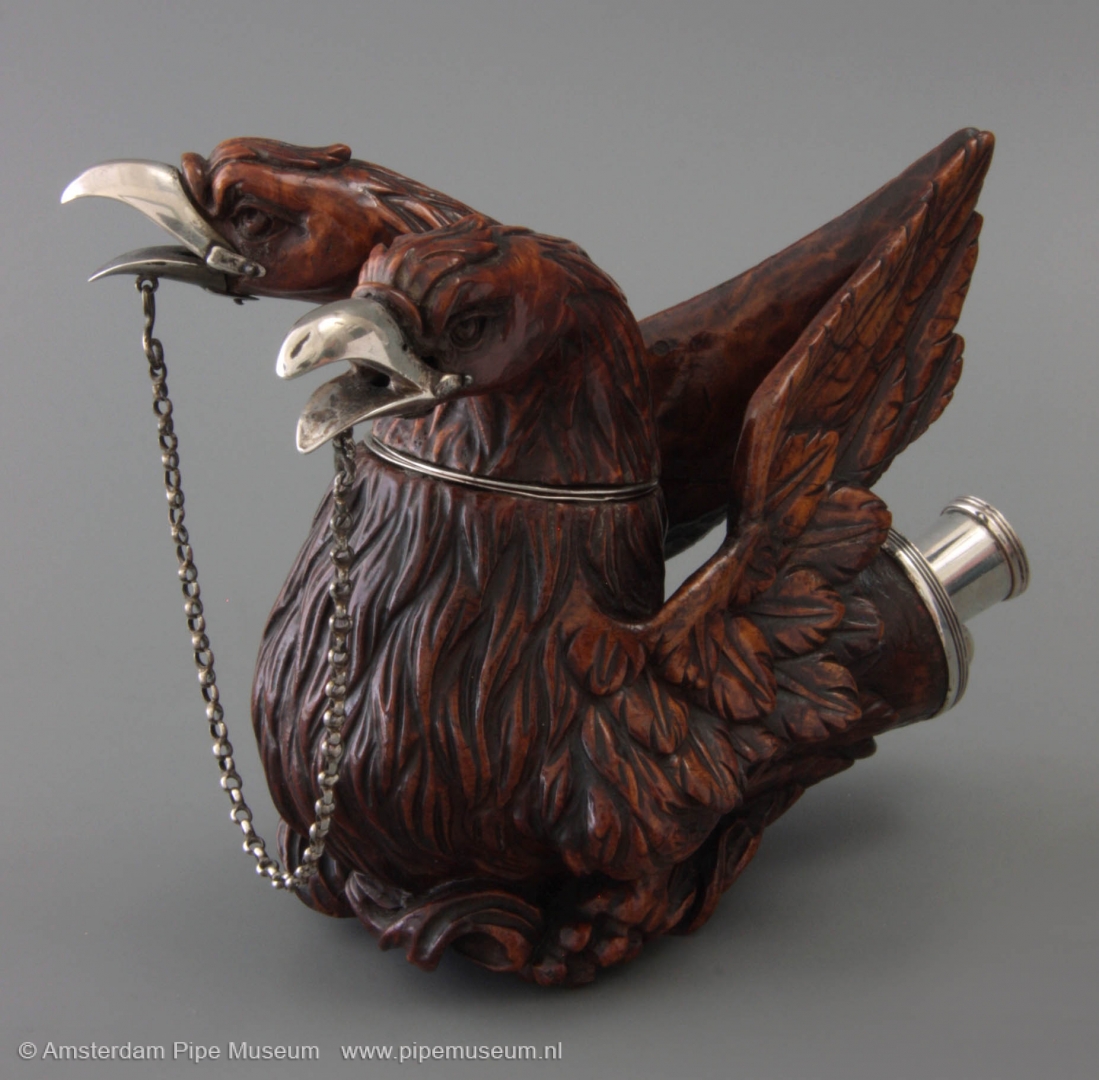
This superb tobacco pipe is more design than functionality, but one of the most beautiful kind. The pipe bowl is shaped fully figuratively and shows a sitting bird with spread wings in most lovely details. A thin silver border around the neck indicates that the top is the lid. The subtile silver caesura between the pipe bowl and the lid in the bird's neck is visible but by no means disturbing. Here, the neck splits remarkably into two heads. The curved silver beaks make it clear that it is a bird of prey, a vulture or eagle. In the case of an eagle, a reference to heraldry is obvious, where it is often depicted as a double-headed animal. Unlike in heraldry, where the bird is always highly abstracted, we see a lifelike image here.
The pipe exudes a great deal of luxury due to the chic interplay between the chestnut brown wood and the silver mounting. For example, notice the silver beaks that contrast spendidly with the heads of the birds, linked by a silver chain. These decorative or practical chains have been in use since the first half of the eighteenth century and can be found well into the nineteenth century. Apart of being a luxury item, it is also a great pipe for smoking. The air supply for the pipe bowl is through the necks of both animals and two small holes in the beaks. When smoking the pipe, a cloud of smoke will occasionally escape from the two beaks. This adds a magical effect to the already fairylike double-headed bird.
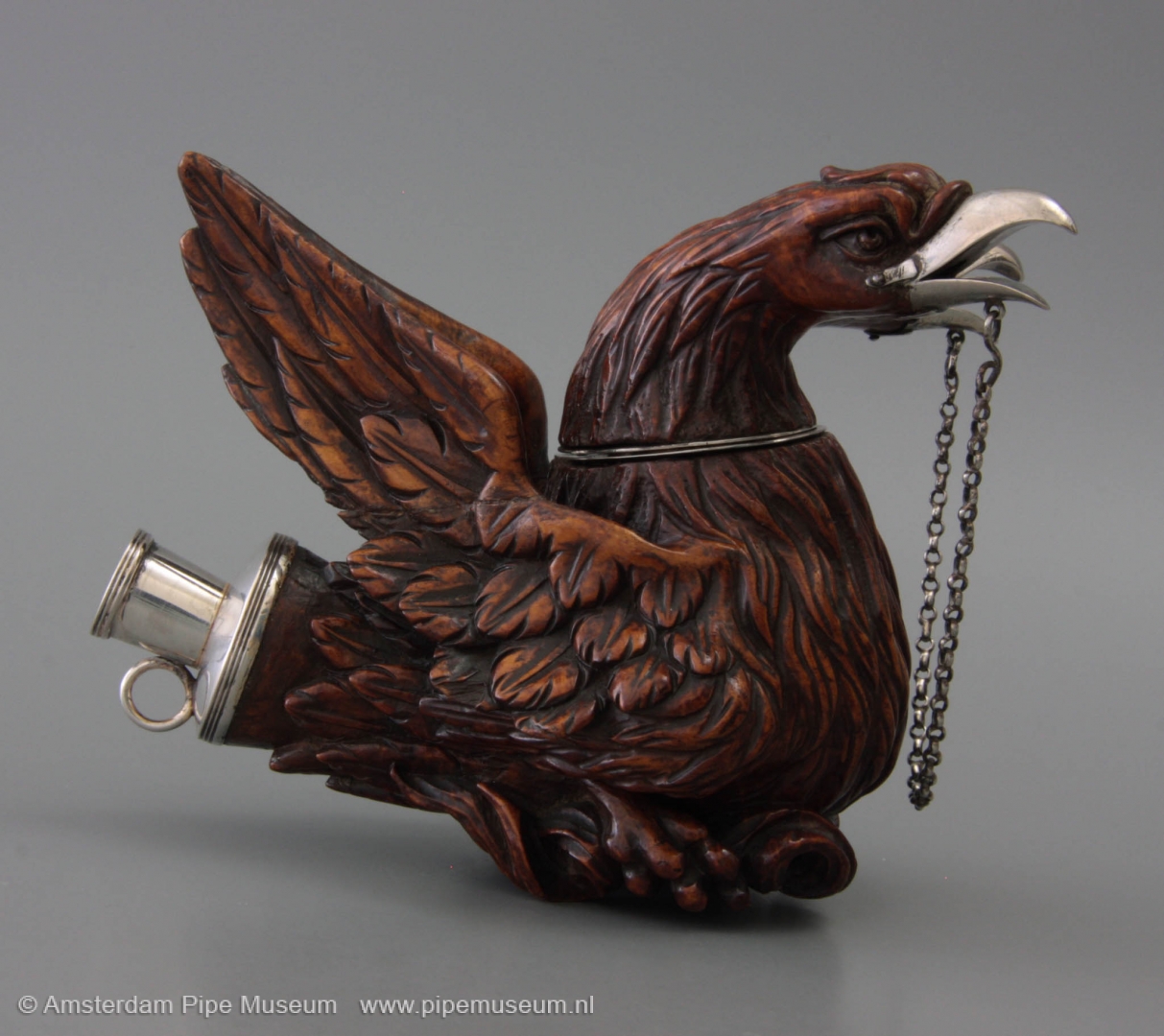
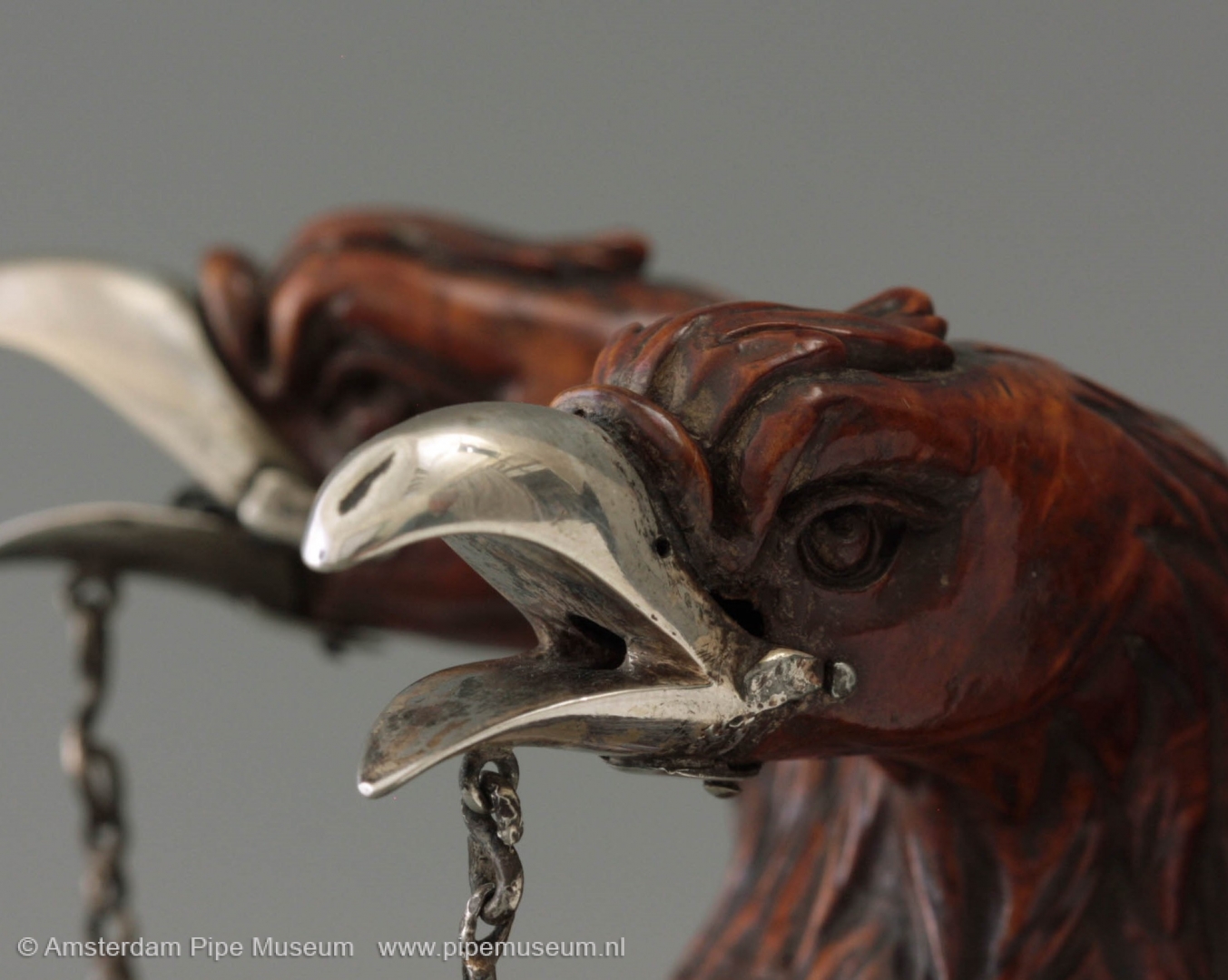
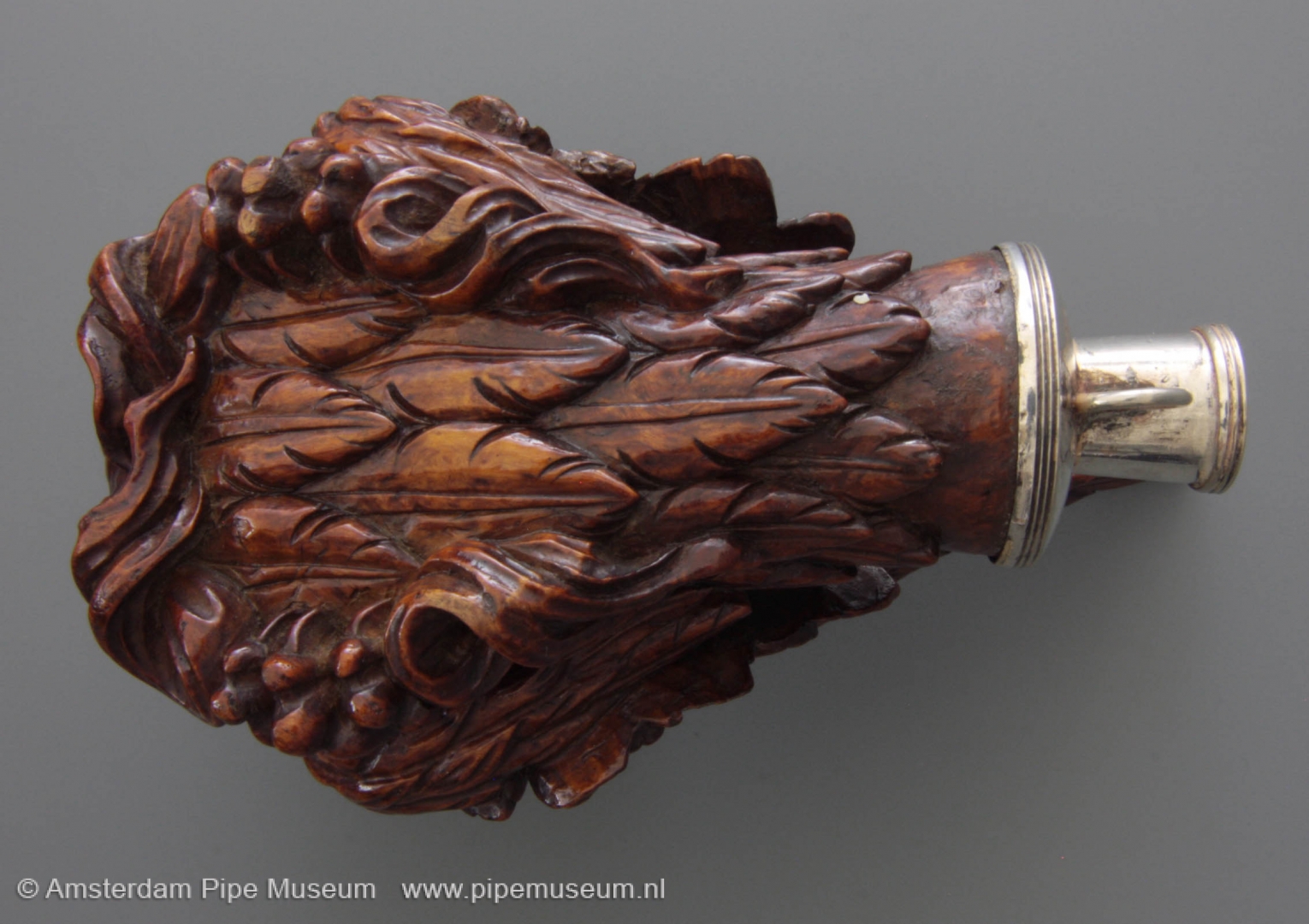
The base of the bowl shows an array of feathers between a pair of creepy eagle claws ending in a scrall of feather or fur that might indicate a nest. Because the product is made of a relatively soft type of wood, the bowl is coated internally with meerschaum paste. The stub has a silver fitting with the usual stem plate and conical stem holder with locking eye. Such silverwork groups the product under the common tobacco pipes that are mounted in the same way.
The origin must probably be Germany, where many pipes are made of soft wood. Since we have too little information about the production of individual specimen from other areas, it cannot be ruled out that this specimen happens to come from another region in Europe. The dating is difficult to determined as well. For the time being we will keep this to a period around 1820, although due to the fineness of the work this pipe may have been created already in the eighteenth century. It is an example of a luxury pipe of a beautiful design, of which the excellent execution lifts it above every standard.
Amsterdam Pipe Museum APM 20.326
As curious as meritorious
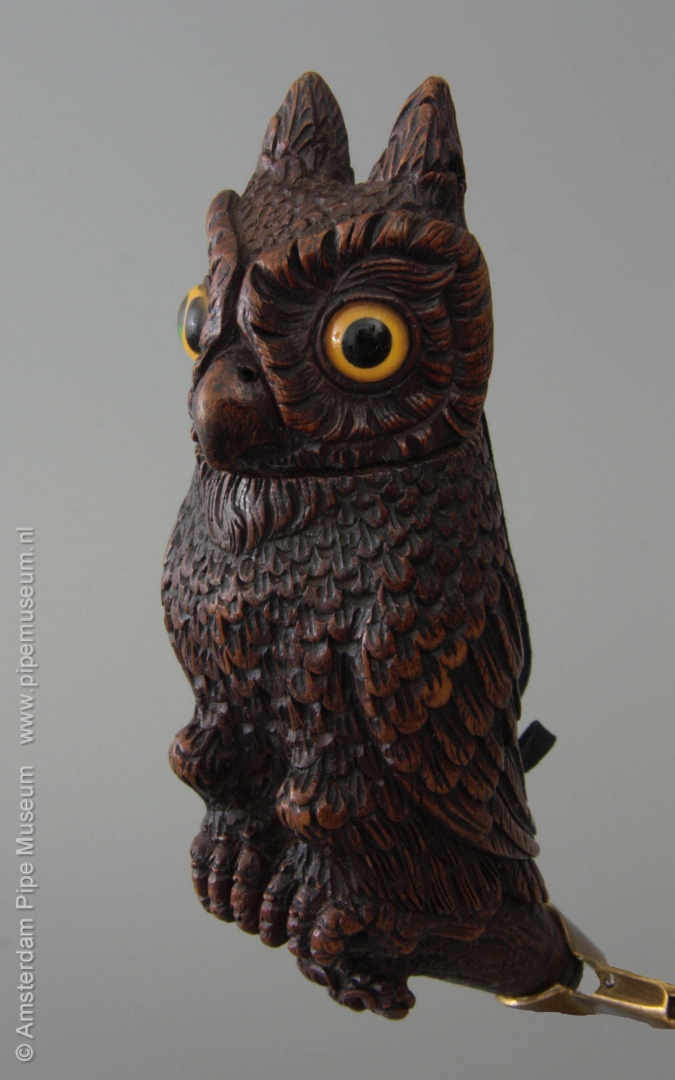
With some pipes, the maker loses sight of the purpose of use and is focussing exclusively on the design. That seems to be the case with this wooden tobacco pipe whose bowl is shaped as a sitting owl, while the moisture reservoir represents a swan. If one is not very keen on decorating and figuration, this is an abomination. On the other hand, anyone who has tried to carve a figure out of wood himself shall realize how much craftsmanship is in this pipe and how original the design is.
Let’s look at the pipe bowl: it follows the usual oval bowl shape, customary for that period and is equipped with a lid as is common in most German pipes. However, the design of a sitting owl is very convincing because the animal exudes the patience and dignity typical for an owl. The pattern of the feathers has been cut out in detail with the utmost care. Very appropriately, the air holes for the lid are quite inconspicuously hidden in the nostrils of the beak of the animal. By adding glass eyes, it gets the sympathetic look of a toy animal.
In the end, this pipe is completely functional. The beautiful fine wood has been doubled on the inside with a sheet-metal mantel to protect it from burning in. The German pipe makers have been doing that since the seventeenth century. In addition, the drillings to the stem and the moisture reservoir are optimal so that the pipe guarantees a good draft..
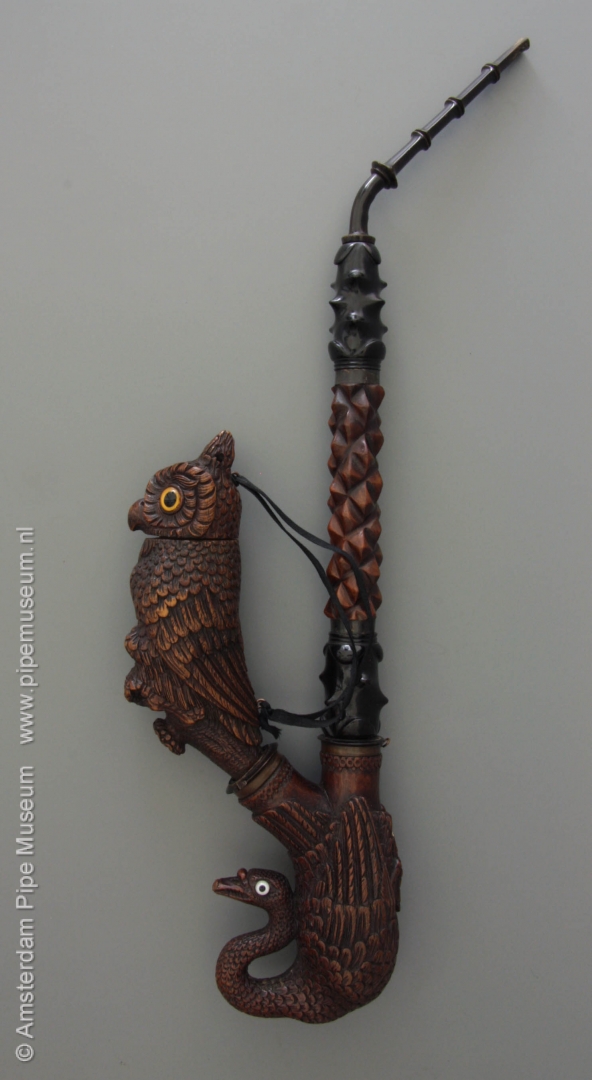
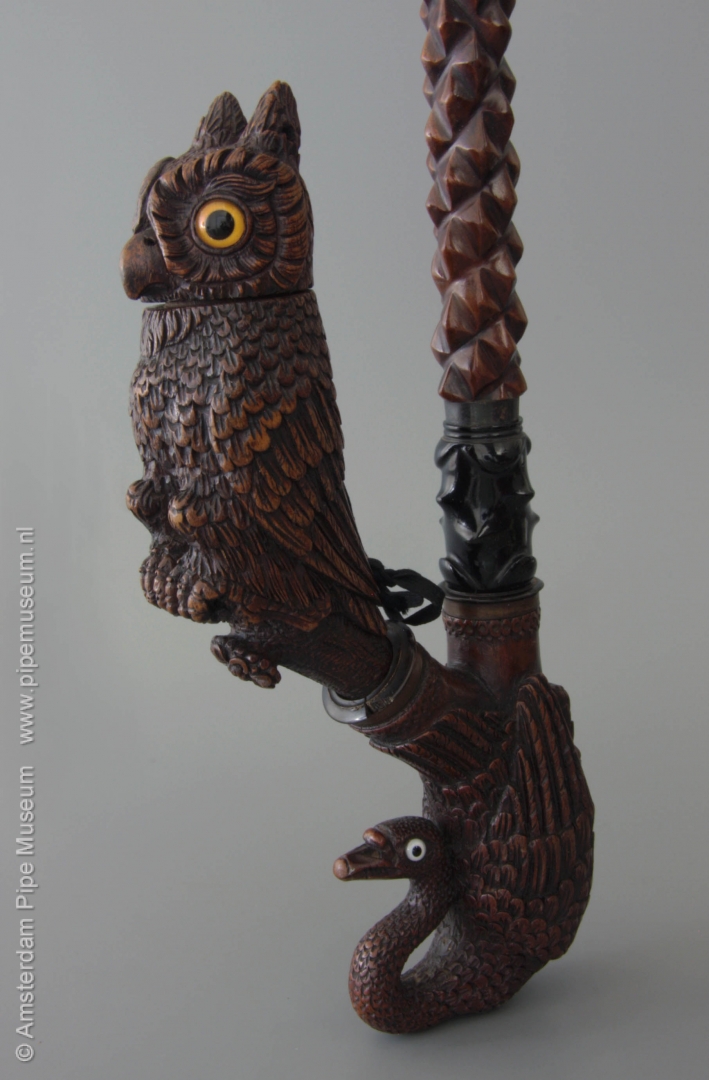
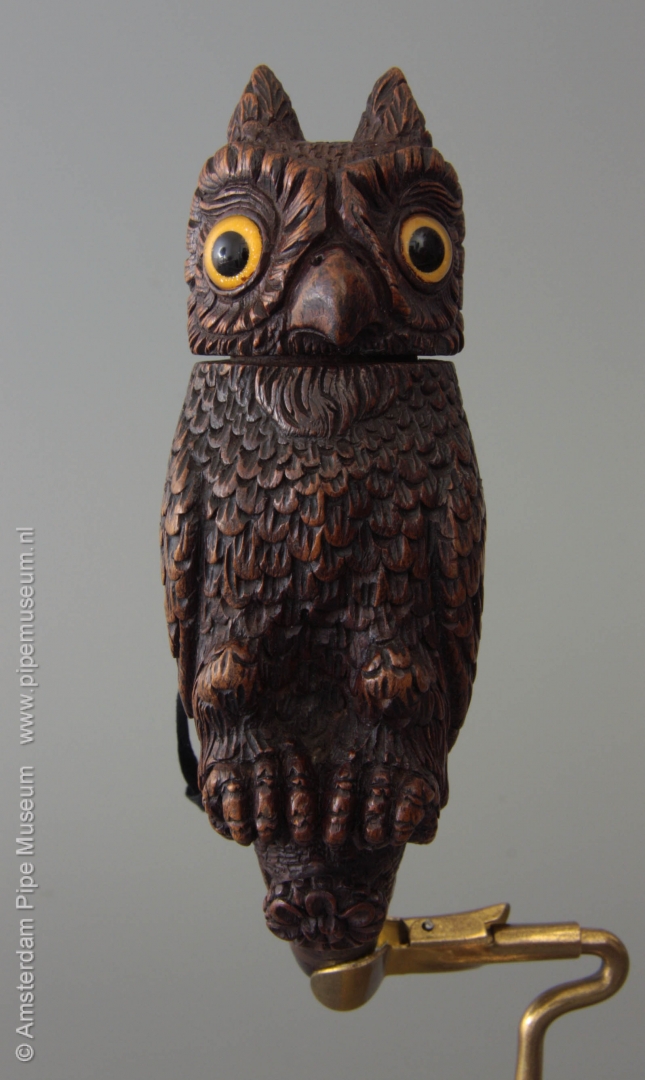
The moisture reservoir itself, also a standard part of the German Gesteckpfeife, is designed in a less natural way. The decoration follows the usual bag shape so that the swan with its long neck gets a quite artificial posture. Did the creator attempt to express that the swan had fallen into the claws of the owl or did he not see a better solution for the design? Again, the comparable glass eyes were added, which were considered to be more pronounced than to drill pupils into the wood.
Fortunately, the pipe was preserved as a whole with its original mounting of stem and mouthpiece. Here we see how strong the Gesamtkunstwerk is. The materials including the carving of the stem fit in seamlessly with the pipe bowl. Moreover, the alternation of the brown wood and greenish-black buffalo horn is very attractive. The stem shows a rhythmic pattern of diamond shapes. The horn work, possibly made by a befriended horn turner, has the same rhythm of sharper points. Colour and material texture provide both strong unity and an attractive contrast.
Those familiar with the design of the German pipe will see that the maker has created a beautifully balanced pipe. It has become a recognizable German Gesteckpfeife, but with an entertaining image of artistic high level. What is unfortunately missing when discussing this pipe is the exact origin. No matter how German in origin it looks, there is no certainty about the exact region of origin nor about the dating. The pipe probably looks more recent than it is. We estimate the date of creation between 1860 and 1890.
Amsterdam Pipe Museum APM 19.837
Pipe of the Prince of the Netherlands
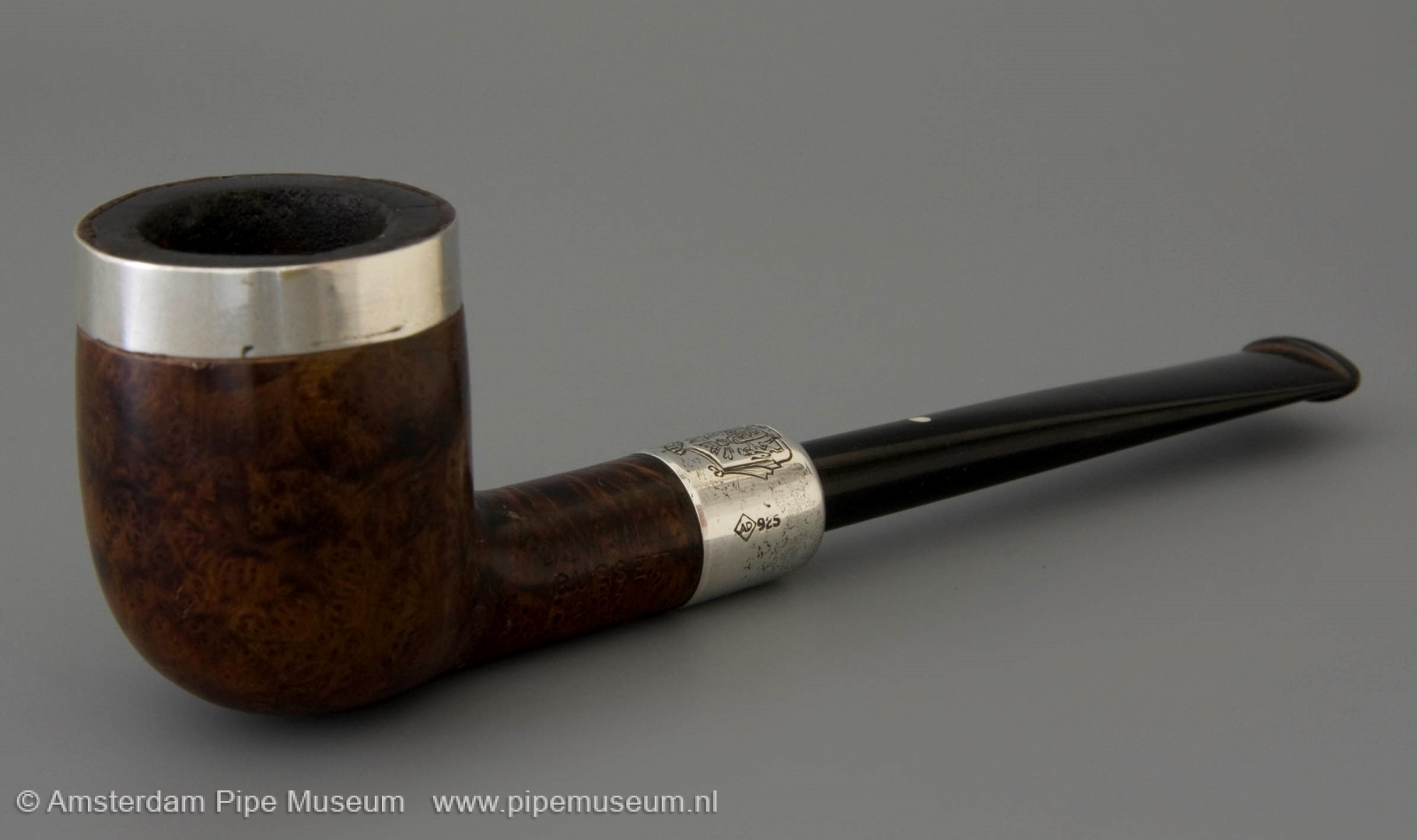
Without doubt, Prince Bernhard, consort of Queen Juliana, is the most famous Dutch pipe smoker of the twentieth century. For the prince, smoking was not only a hobby for an optimal taste experience, but also an expression of fashion and style, a part of his image, as important as his white buttonhole carnation. For the prince, his pipe became an object to flaunt, always appropriate for the occasion.
Prince Bernhard's favourite brand was Dunhill, the brand for smokers who can distinguish and hanker for quality. On many of his portrait photographs the subtle but exclusive mark of the white dot on the mouthpiece can be discerned. But a prince with panache and charm used the pipe not simply as a status symbol, but especially as a fashion accessory. As no individual one can see so well that the choice of his pipe corresponds to the clothing as it is fitting to a specific occasion. Sporty or just dressed, modest and unobtrusive or just flamboyant and extravert, the pipe goes along with all expressions, if well chosen. Especially for that choice, the prince had the discerning eye: during painting a rusticated meerschaum with gentle bend, for a gala an implacable straight dress with a modest silver band.
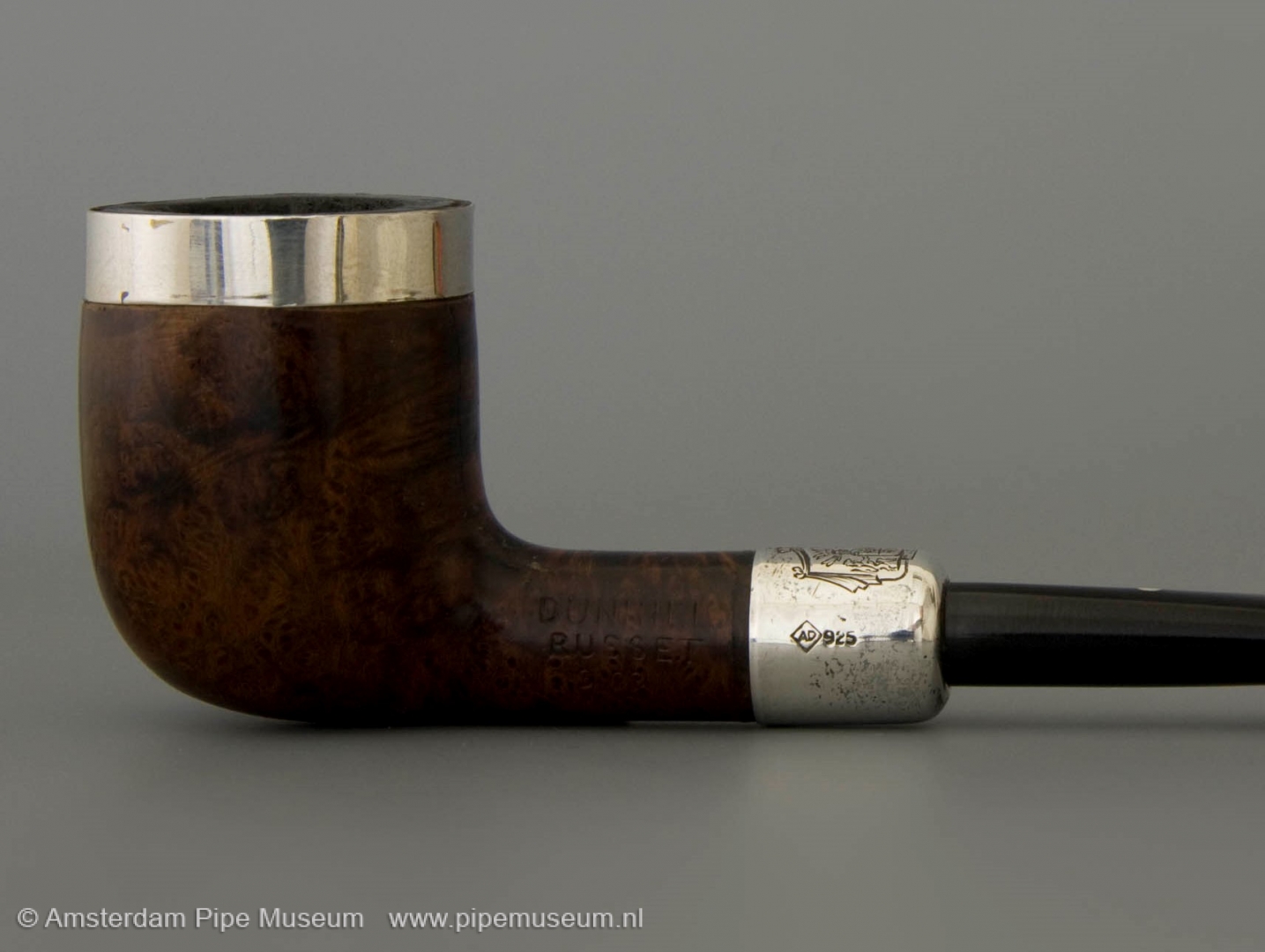
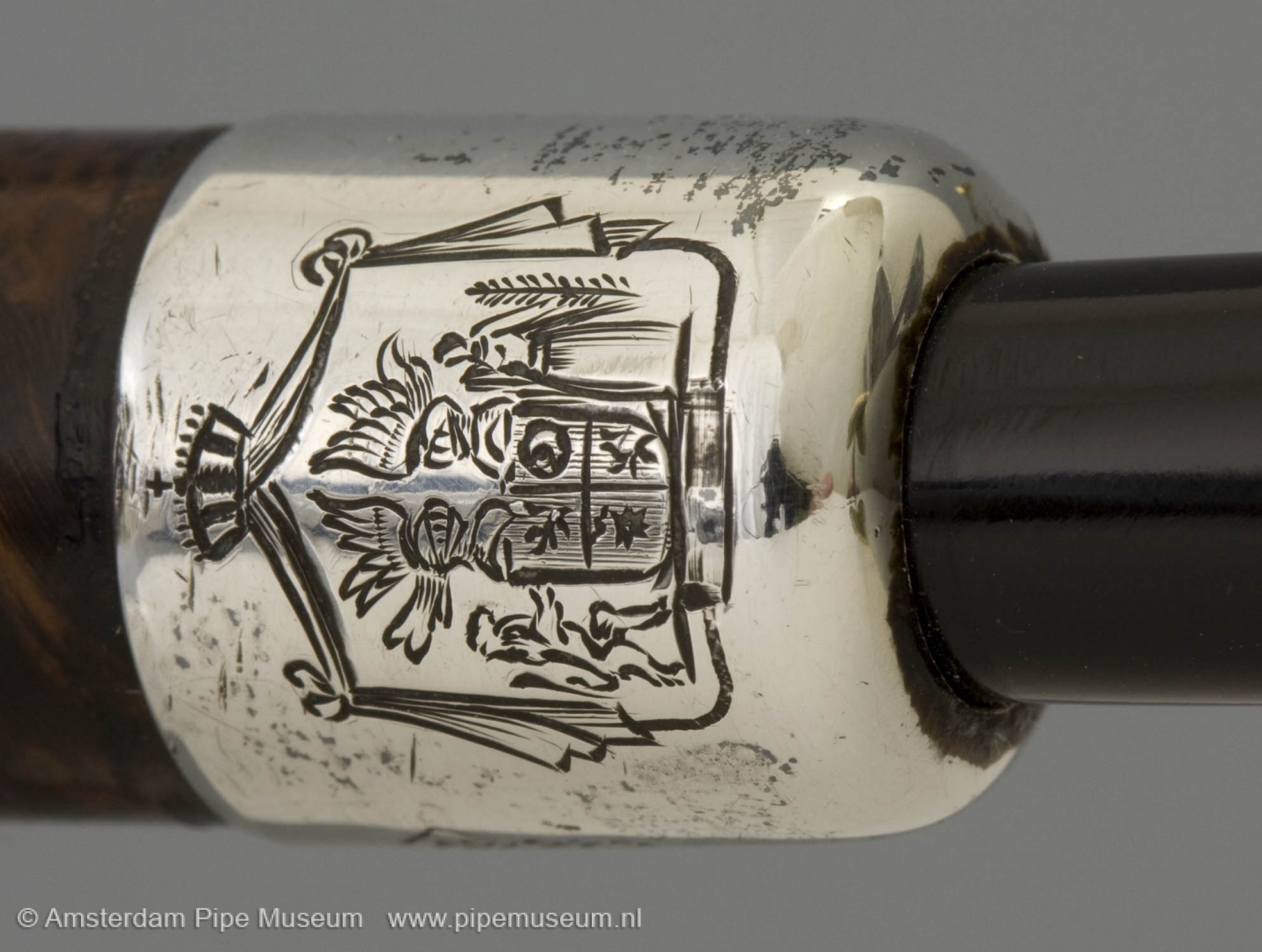
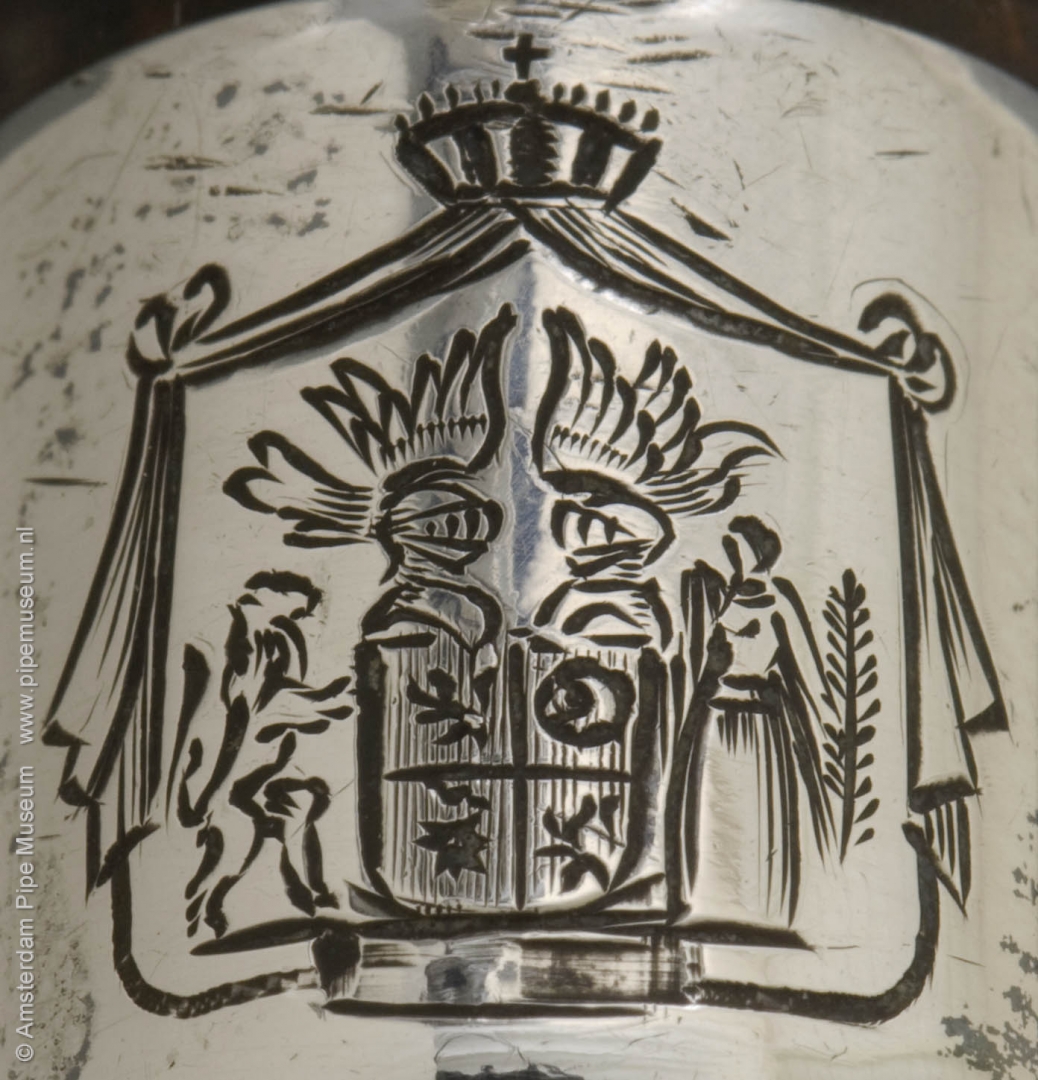
But a pipe is not merely an expression of fashion. It is first and foremost a commodity item, comfortable in the hand, with a bowl size that matches the cut of the tobacco and the duration of the moment of smoking. The prince bought his pipes with these criteria: inspecting the shape personally, see if they were well handleable and fit his posture. Fitting a pipe in front of the mirror was not necessary for the prince, he knew how to make his choice. Although he listened carefully to advice, he always took the decision himself.
One pipe smokes better than the other, that secret cannot be provided at purchase but the smoker has to experience that by trial and error. One of Bernhard's favourites was the Dunhill pictured here from the year 1992. An ordinary shape but a top brand. A beloved pipe because it smoked so well, but also because the Prince received this particular pipe as a gift at a personal jubilee. For that occasion the family had engraved the coat of arms of Von Lippe-Biesterfeld in the silver band around the briar stem end. Thus this pipe became even more personal than all other Dunhill’s that the prince possessed. Since then the pipe has been smoked almost to its end, until the pipe repairer even had to put a silver band around the bowl to prevent bursting. Let's be honest, even a Dunhill wears through use.
After ten years of loyal service, it was time to give the pipe a new destination. Prince Bernhard offered it to the Amsterdam Pipe Museum, accompanied by a portrait on which he is depicted with his favourite. An ode to pipe smoking but also a token of appreciation for the piece of historical work that the museum performs in preserving the culture of pipe smoking.
Amsterdam Pipe Museum APM 16.874